

Technology over the long run: zoom out to see how dramatically the world can change within a lifetime
It is easy to underestimate how much the world can change within a lifetime. considering how dramatically the world has changed can help us see how different the world could be in a few years or decades..
Technology can change the world in ways that are unimaginable until they happen. Switching on an electric light would have been unimaginable for our medieval ancestors. In their childhood, our grandparents would have struggled to imagine a world connected by smartphones and the Internet.
Similarly, it is hard for us to imagine the arrival of all those technologies that will fundamentally change the world we are used to.
We can remind ourselves that our own future might look very different from the world today by looking back at how rapidly technology has changed our world in the past. That’s what this article is about.
One insight I take away from this long-term perspective is how unusual our time is. Technological change was extremely slow in the past – the technologies that our ancestors got used to in their childhood were still central to their lives in their old age. In stark contrast to those days, we live in a time of extraordinarily fast technological change. For recent generations, it was common for technologies that were unimaginable in their youth to become common later in life.
The long-run perspective on technological change
The big visualization offers a long-term perspective on the history of technology. 1
The timeline begins at the center of the spiral. The first use of stone tools, 3.4 million years ago, marks the beginning of this history of technology. 2 Each turn of the spiral represents 200,000 years of history. It took 2.4 million years – 12 turns of the spiral – for our ancestors to control fire and use it for cooking. 3
To be able to visualize the inventions in the more recent past – the last 12,000 years – I had to unroll the spiral. I needed more space to be able to show when agriculture, writing, and the wheel were invented. During this period, technological change was faster, but it was still relatively slow: several thousand years passed between each of these three inventions.
From 1800 onwards, I stretched out the timeline even further to show the many major inventions that rapidly followed one after the other.
The long-term perspective that this chart provides makes it clear just how unusually fast technological change is in our time.
You can use this visualization to see how technology developed in particular domains. Follow, for example, the history of communication: from writing to paper, to the printing press, to the telegraph, the telephone, the radio, all the way to the Internet and smartphones.
Or follow the rapid development of human flight. In 1903, the Wright brothers took the first flight in human history (they were in the air for less than a minute), and just 66 years later, we landed on the moon. Many people saw both within their lifetimes: the first plane and the moon landing.
This large visualization also highlights the wide range of technology’s impact on our lives. It includes extraordinarily beneficial innovations, such as the vaccine that allowed humanity to eradicate smallpox , and it includes terrible innovations, like the nuclear bombs that endanger the lives of all of us .
What will the next decades bring?
The red timeline reaches up to the present and then continues in green into the future. Many children born today, even without further increases in life expectancy, will live well into the 22nd century.
New vaccines, progress in clean, low-carbon energy, better cancer treatments – a range of future innovations could very much improve our living conditions and the environment around us. But, as I argue in a series of articles , there is one technology that could even more profoundly change our world: artificial intelligence (AI).
One reason why artificial intelligence is such an important innovation is that intelligence is the main driver of innovation itself. This fast-paced technological change could speed up even more if it’s driven not only by humanity’s intelligence but also by artificial intelligence. If this happens, the change currently stretched out over decades might happen within a very brief time span of just a year. Possibly even faster. 4
I think AI technology could have a fundamentally transformative impact on our world. In many ways, it is already changing our world, as I documented in this companion article . As this technology becomes more capable in the years and decades to come, it can give immense power to those who control it (and it poses the risk that it could escape our control entirely).
Such systems might seem hard to imagine today, but AI technology is advancing quickly. Many AI experts believe there is a real chance that human-level artificial intelligence will be developed within the next decades, as I documented in this article .
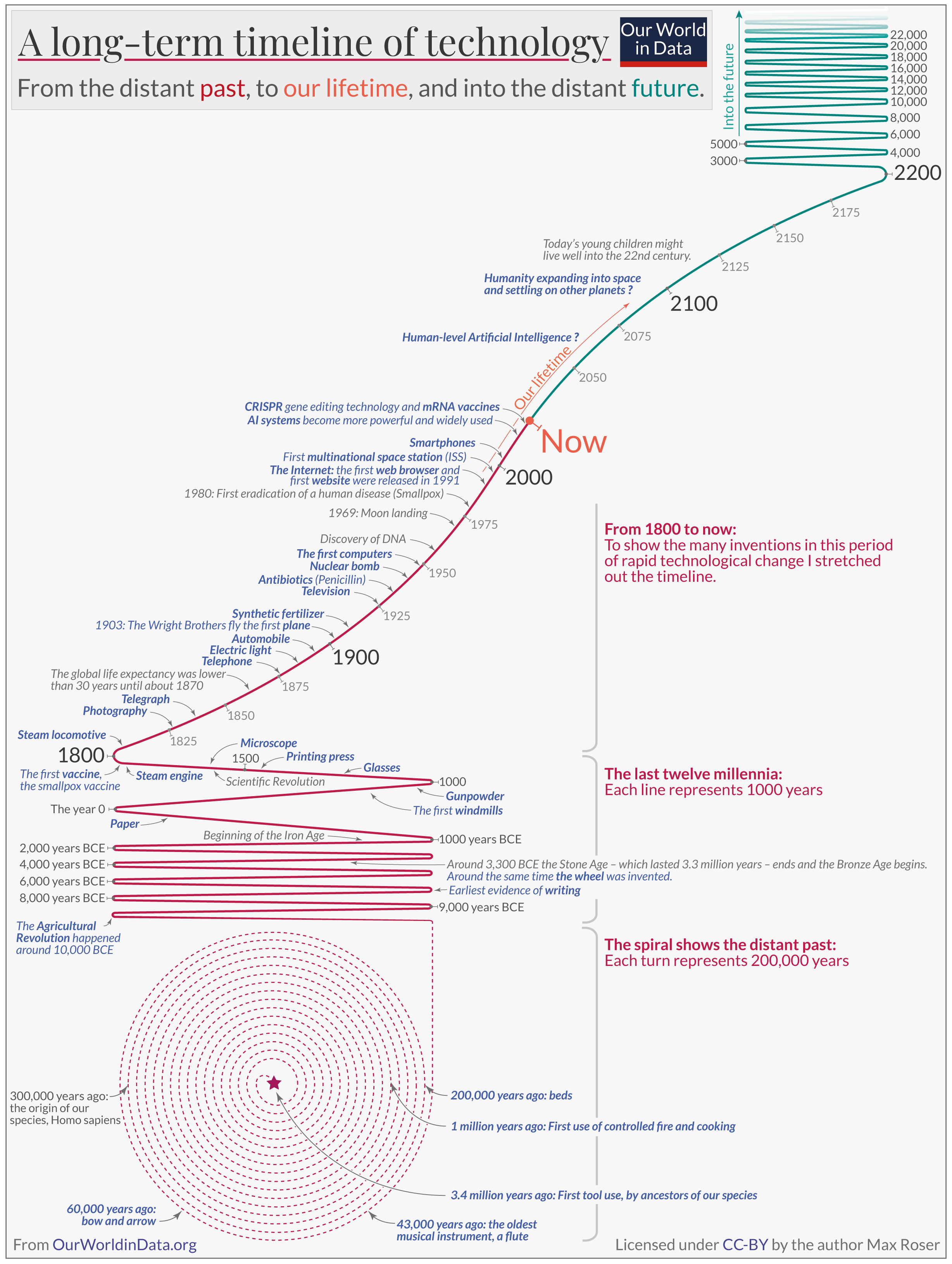
Technology will continue to change the world – we should all make sure that it changes it for the better
What is familiar to us today – photography, the radio, antibiotics, the Internet, or the International Space Station circling our planet – was unimaginable to our ancestors just a few generations ago. If your great-great-great grandparents could spend a week with you, they would be blown away by your everyday life.
What I take away from this history is that I will likely see technologies in my lifetime that appear unimaginable to me today.
In addition to this trend towards increasingly rapid innovation, there is a second long-run trend. Technology has become increasingly powerful. While our ancestors wielded stone tools, we are building globe-spanning AI systems and technologies that can edit our genes.
Because of the immense power that technology gives those who control it, there is little that is as important as the question of which technologies get developed during our lifetimes. Therefore, I think it is a mistake to leave the question about the future of technology to the technologists. Which technologies are controlled by whom is one of the most important political questions of our time because of the enormous power these technologies convey to those who control them.
We all should strive to gain the knowledge we need to contribute to an intelligent debate about the world we want to live in. To a large part, this means gaining knowledge and wisdom on the question of which technologies we want.
Acknowledgments: I would like to thank my colleagues Hannah Ritchie, Bastian Herre, Natasha Ahuja, Edouard Mathieu, Daniel Bachler, Charlie Giattino, and Pablo Rosado for their helpful comments on drafts of this essay and the visualization. Thanks also to Lizka Vaintrob and Ben Clifford for the conversation that initiated this visualization.
Appendix: About the choice of visualization in this article
The recent speed of technological change makes it difficult to picture the history of technology in one visualization. When you visualize this development on a linear timeline, then most of the timeline is almost empty, while all the action is crammed into the right corner:

In my large visualization here, I tried to avoid this problem and instead show the long history of technology in a way that lets you see when each technological breakthrough happened and how, within the last millennia, there was a continuous acceleration of technological change.
The recent speed of technological change makes it difficult to picture the history of technology in one visualization. In the appendix, I show how this would look if it were linear.
It is, of course, difficult to assess when exactly the first stone tools were used.
The research by McPherron et al. (2010) suggested that it was at least 3.39 million years ago. This is based on two fossilized bones found in Dikika in Ethiopia, which showed “stone-tool cut marks for flesh removal and percussion marks for marrow access”. These marks were interpreted as being caused by meat consumption and provide the first evidence that one of our ancestors, Australopithecus afarensis, used stone tools.
The research by Harmand et al. (2015) provided evidence for stone tool use in today’s Kenya 3.3 million years ago.
References:
McPherron et al. (2010) – Evidence for stone-tool-assisted consumption of animal tissues before 3.39 million years ago at Dikika, Ethiopia . Published in Nature.
Harmand et al. (2015) – 3.3-million-year-old stone tools from Lomekwi 3, West Turkana, Kenya . Published in Nature.
Evidence for controlled fire use approximately 1 million years ago is provided by Berna et al. (2012) Microstratigraphic evidence of in situ fire in the Acheulean strata of Wonderwerk Cave, Northern Cape province, South Africa , published in PNAS.
The authors write: “The ability to control fire was a crucial turning point in human evolution, but the question of when hominins first developed this ability still remains. Here we show that micromorphological and Fourier transform infrared microspectroscopy (mFTIR) analyses of intact sediments at the site of Wonderwerk Cave, Northern Cape province, South Africa, provide unambiguous evidence—in the form of burned bone and ashed plant remains—that burning took place in the cave during the early Acheulean occupation, approximately 1.0 Ma. To the best of our knowledge, this is the earliest secure evidence for burning in an archaeological context.”
This is what authors like Holden Karnofsky called ‘Process for Automating Scientific and Technological Advancement’ or PASTA. Some recent developments go in this direction: DeepMind’s AlphaFold helped to make progress on one of the large problems in biology, and they have also developed an AI system that finds new algorithms that are relevant to building a more powerful AI.
Cite this work
Our articles and data visualizations rely on work from many different people and organizations. When citing this article, please also cite the underlying data sources. This article can be cited as:
BibTeX citation
Reuse this work freely
All visualizations, data, and code produced by Our World in Data are completely open access under the Creative Commons BY license . You have the permission to use, distribute, and reproduce these in any medium, provided the source and authors are credited.
The data produced by third parties and made available by Our World in Data is subject to the license terms from the original third-party authors. We will always indicate the original source of the data in our documentation, so you should always check the license of any such third-party data before use and redistribution.
All of our charts can be embedded in any site.
Our World in Data is free and accessible for everyone.
Help us do this work by making a donation.

Technology and the self
Tomorrow people
For the entire 20th century, it had felt like telepathy was just around the corner. Why is that especially true now?
Roger Luckhurst

Space exploration
Mind-bending speed is the only way to reach the stars – here are three ways to do it

Film and visual culture
An augmented-reality filter reveals the hidden movements all around us

The skyhook solution
Space junk surrounds Earth, posing a dangerous threat. But there is a way to turn the debris into opportunity
Angelos Alfatzis

Computing and artificial intelligence
A scientist’s poor eyesight helped fuel a revolution in computer ‘vision’

Future of technology
Is this the future of space travel? Take a luxury ‘cruise’ across the solar system

The final ethical frontier
Earthbound exploration was plagued with colonialism, exploitation and extraction. Can we hope to make space any different?
Philip Ball

Artificial ‘creativity’ is unstoppable. Grappling with its ethics is up to us
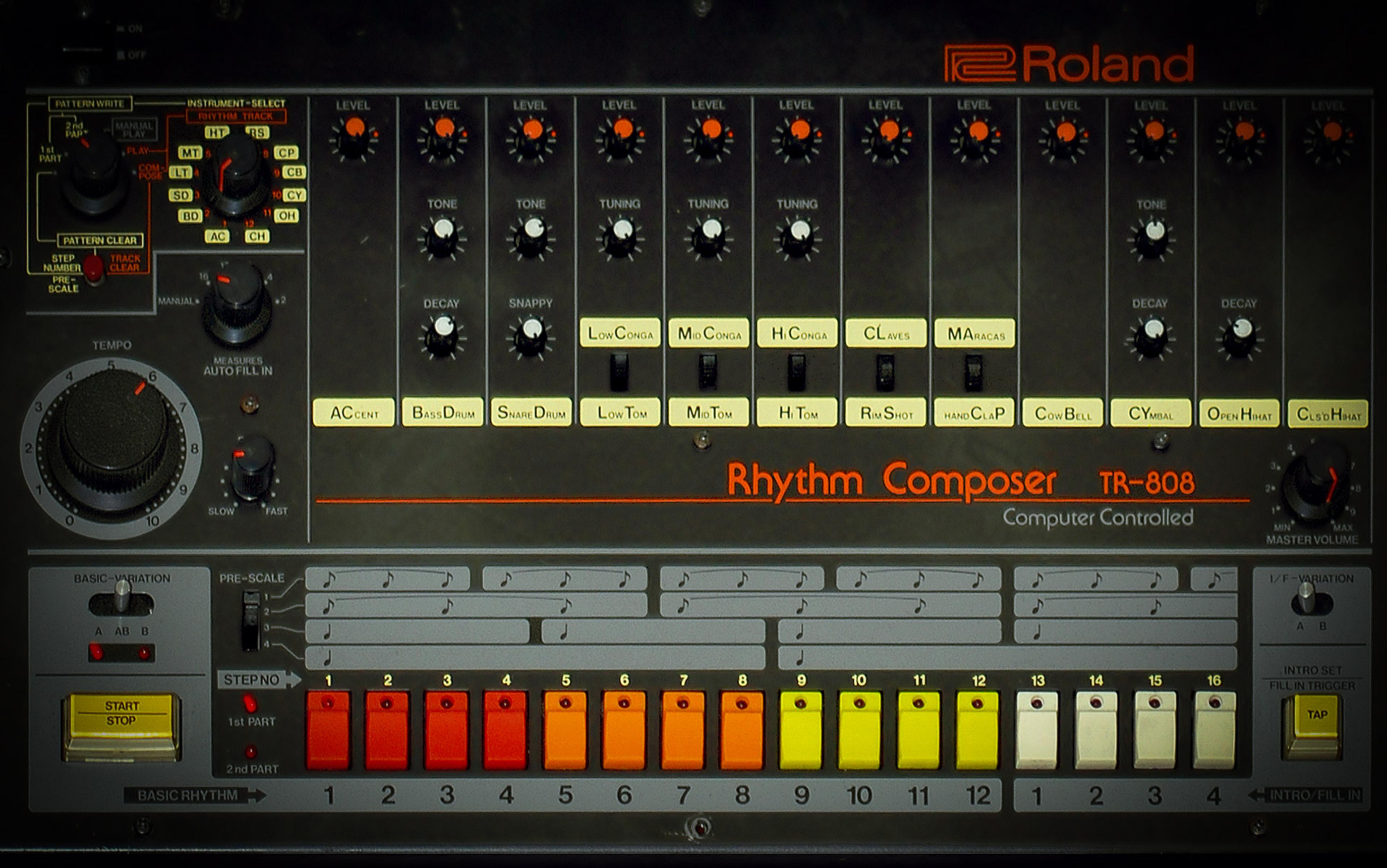
Give the drummer some
As AI drum machines embrace humanising imperfections, what does this mean for ‘real’ drummers and the soul of music?
Jack Stilgoe

With human help, AIs are generating a new aesthetics. The results are trippy

What does an AI make of what it sees in a contemporary art museum?

Ecology and environmental sciences
Producing food while restoring the planet – a glimpse of farming in the future

The environment
The power of shit
Our excrement is a natural, renewable and sustainable resource – if only we can overcome our visceral disgust of it
Lina Zeldovich

When an AI rejects him for life insurance, Mitch wonders if he can escape his fate

Learn from machine learning
The world is a black box full of extreme specificity: it might be predictable but that doesn’t mean it is understandable
David Weinberger

Stories and literature
The cliché writes back
Machine-written literature might offend your tastes but until the dawn of Romanticism most writers were just as formulaic
Yohei Igarashi

Algorithms are sensitive. People are specific. We should exploit their respective strengths

Tech companies shroud their algorithms in secrecy. It’s time to pry open the black box

How vulnerable is the world?
Sooner or later a technology capable of wiping out human civilisation might be invented. How far would we go to stop it?
Nick Bostrom & Matthew van der Merwe
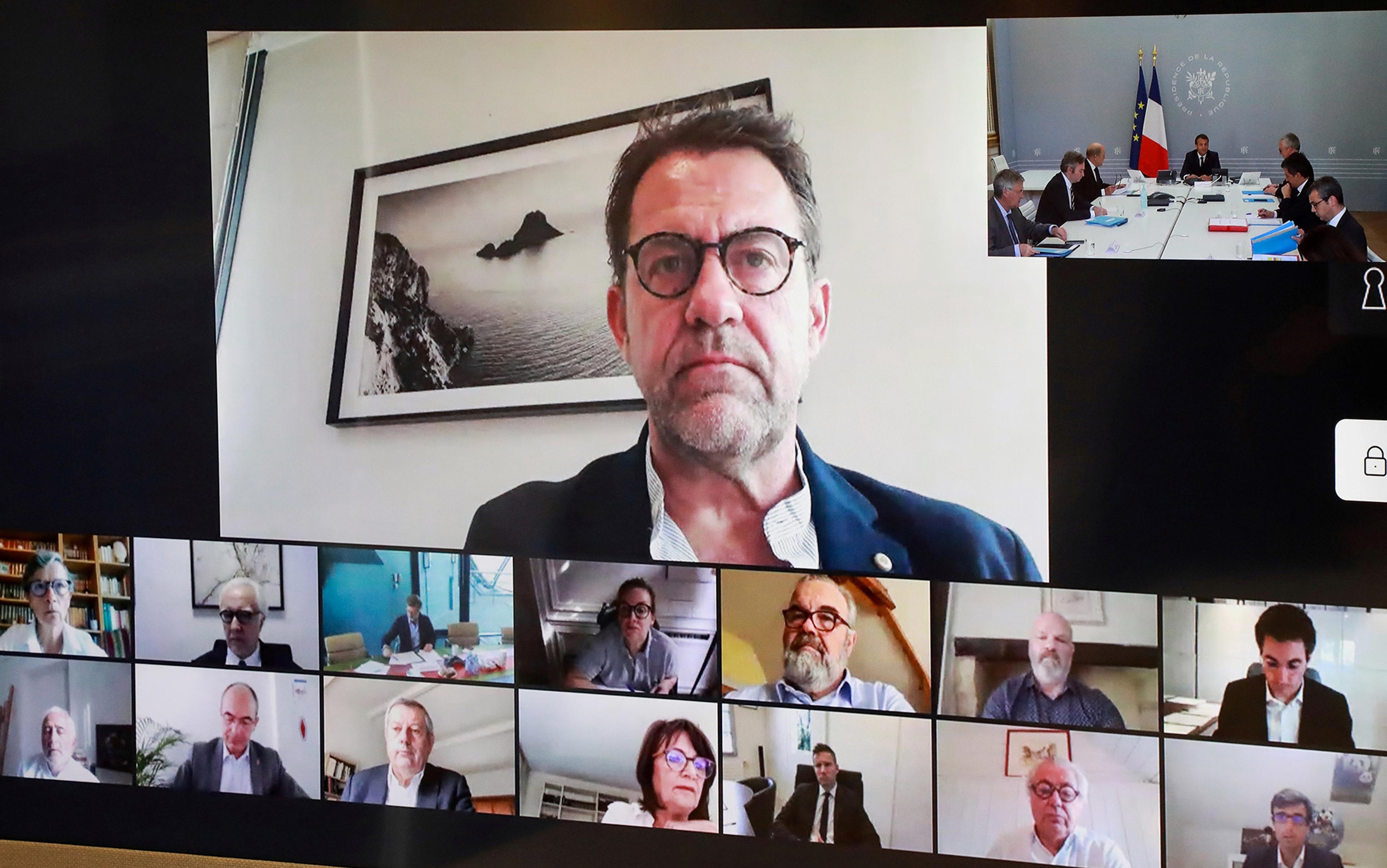
Zoom and gloom
Sitting in a videoconference is a uniformly crap experience. Instead of corroding our humanity, let’s design tools to enhance it
Robert O’Toole
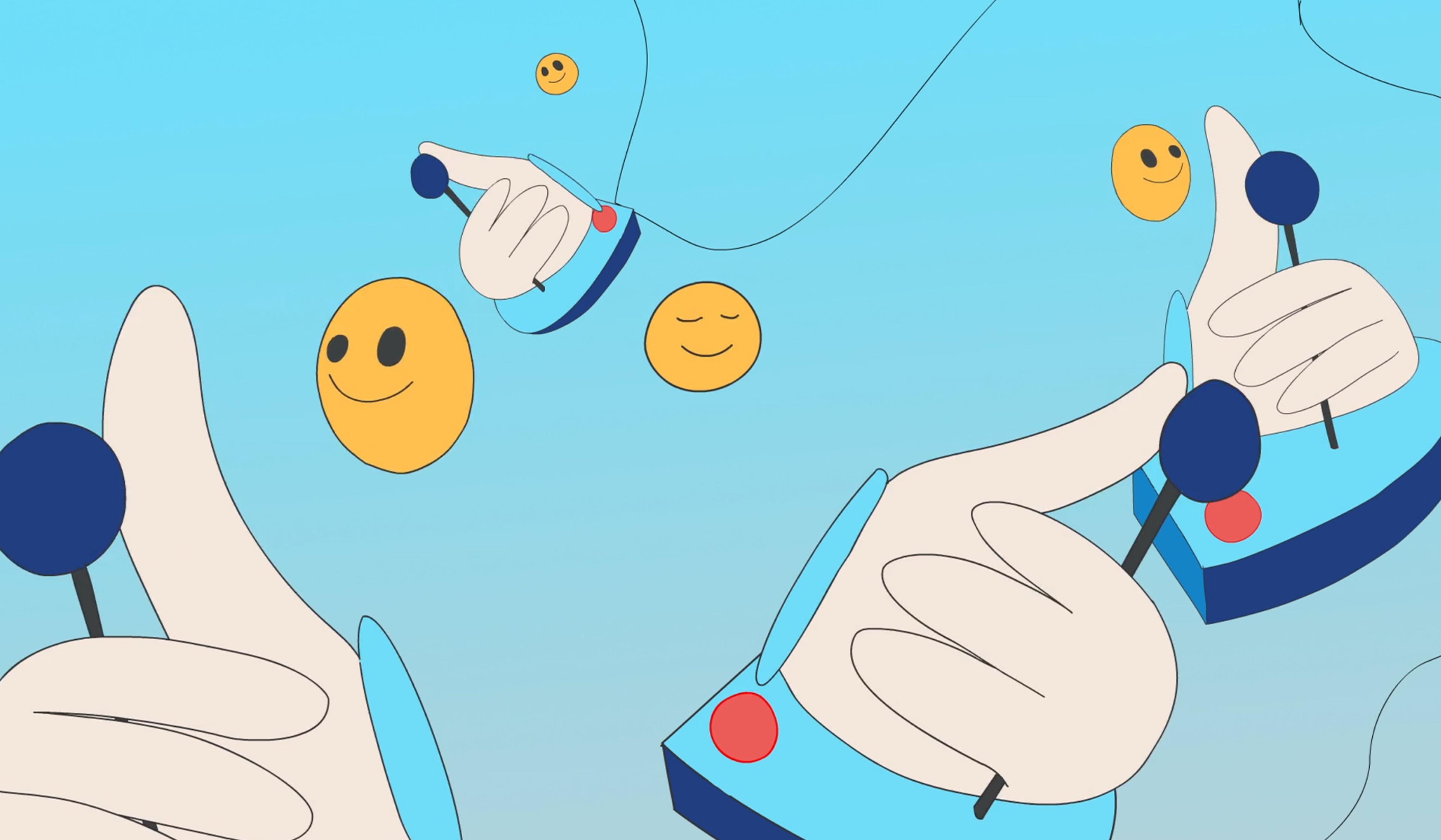
A handful of executives control the ‘attention economy’. Time for attentive resistance
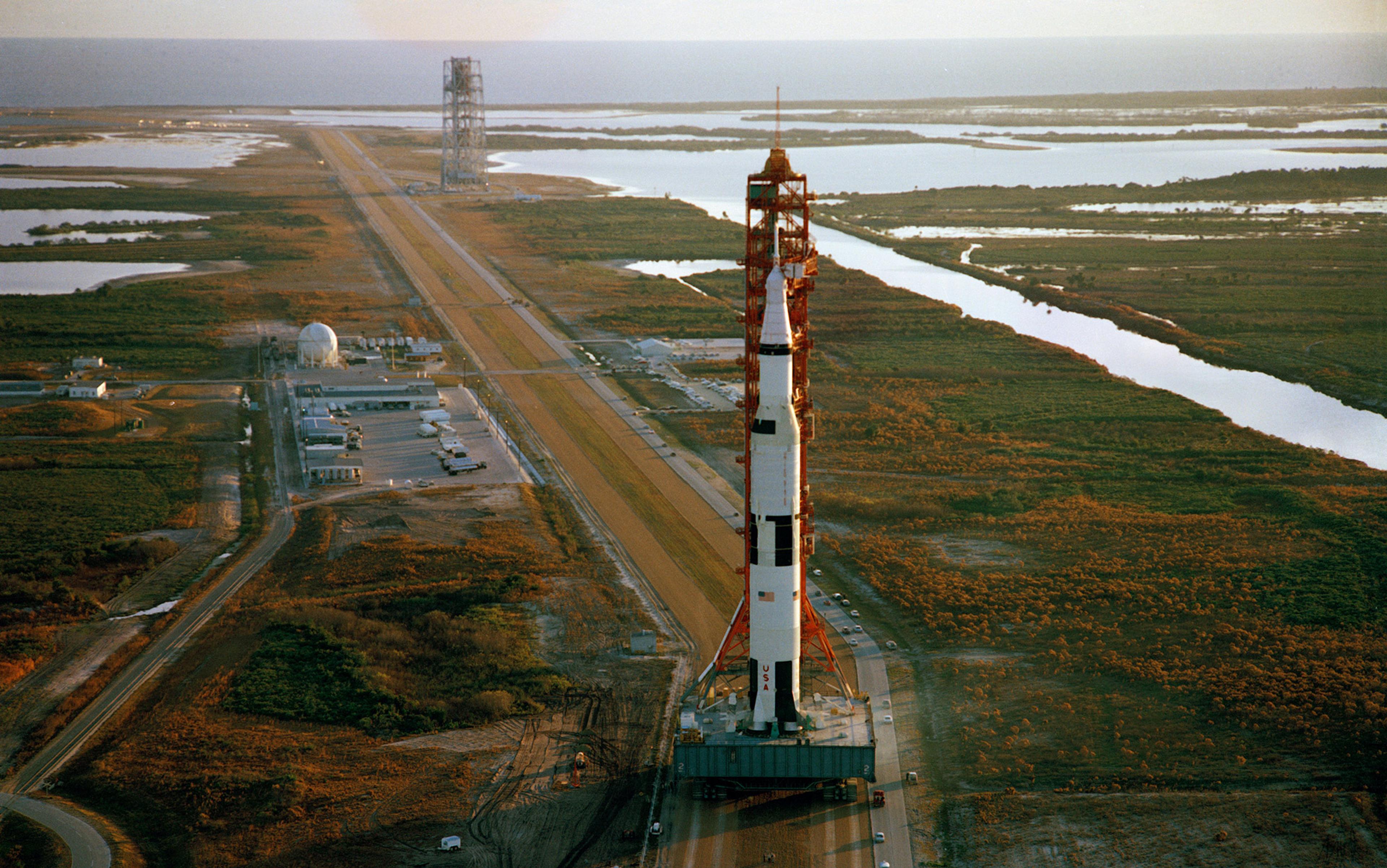
Where did the grandeur go?
Superlative things were done in the past century by marshalling thousands of people in the service of a vision of the future
Martin Parker

Ceramic coral reefs and sawdust houses – the architects 3D-printing the future from scratch

Algorithms associating appearance and criminality have a dark past
Catherine Stinson
- Dissertation
- PowerPoint Presentation
- Book Report/Review
- Research Proposal
- Math Problems
- Proofreading
- Movie Review
- Cover Letter Writing
- Personal Statement
- Nursing Paper
- Argumentative Essay
- Research Paper
- Discussion Board Post
20 Most Prominent Technology Essay Topics And Writing Hints

Table of Contents
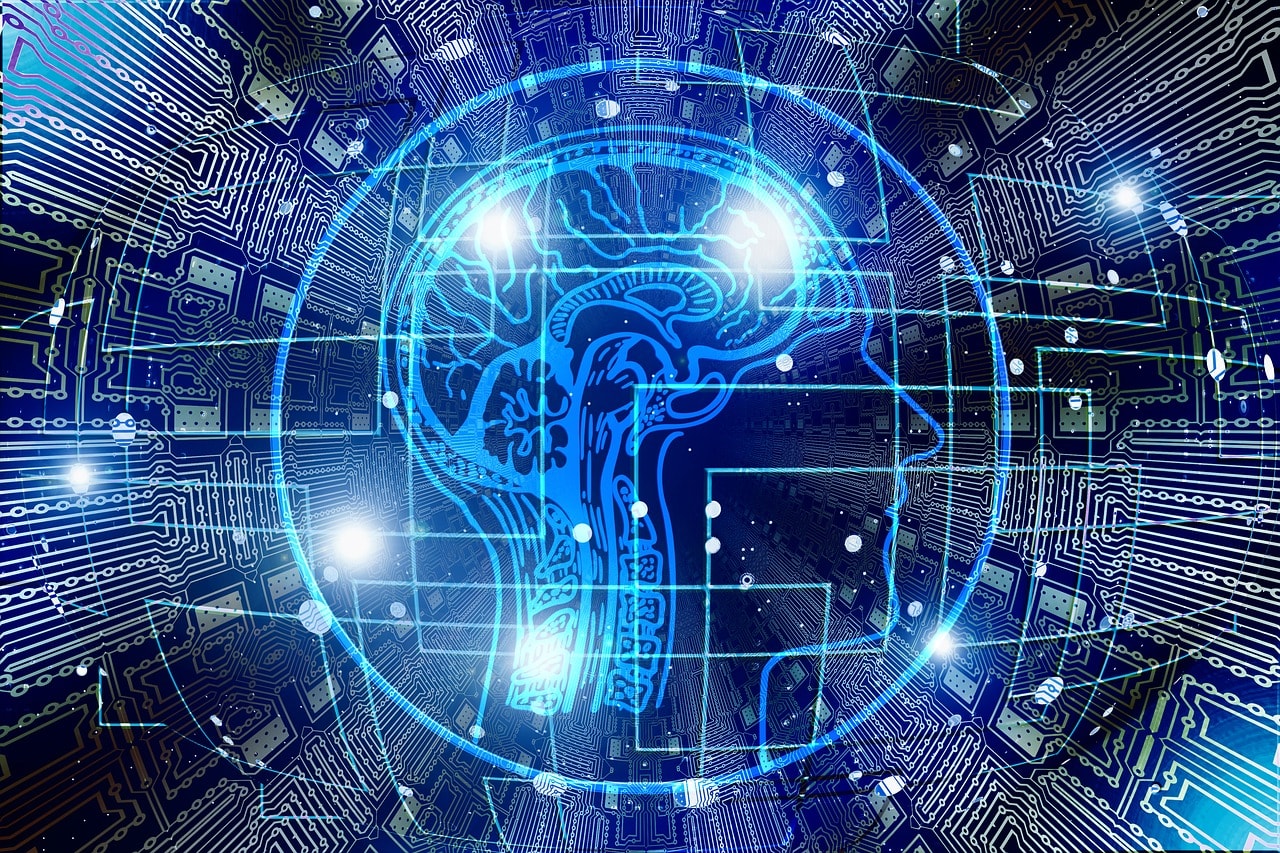
So it goes without saying that the scope of technology is an endless sphere to examine. What’s more, as the topic is super wide, you can personalize your essay to make it enjoyable to work on.
Nevertheless, it may be a challenge for you to make up your mind on how and what to write about. In this case, I hope the following hints will be of great help to you!
How to choose a topic about technology for a research paper?
First of all, to write a technology essay , you need to come up with a topic that will not be too wide, yet not too narrow.
Also, remember that it will be much more entertaining and easier for you to work on the questions you actually enjoy.
If you have troubles composing the topic for your research paper, try some o the following guidelines:
- Think of the aspects of technology you’re interested in.
- Choose issues that are up-to-date and newsworthy .
- Examine credible sources ; find out which questions are best covered with relevant information.
- Write down some keywords for the remaining questions, – they will be the basis of the topic. In case you’ve got too many aspects to cover, try choosing 2-3 of them.
- Try crafting a couple of topics . In case of emergency… find some ready-to-use ideas.
- Look through your final ideas and pick the one you like most.
- Do some preliminary research . Correct your topic if needed.
TOP 20 technology essay topics
Can’t come up with the idea for your perfect topic? How about choosing one from a brilliant list we’ve created for you?
- To what extent technology has changed the way people communicate?
- Pick up one technological invention (Internet/television/electro cars/mobile phones, etc.) and describe how it affected people’s lives.
- History of technological progress: the first technological discoveries.
- What would life be without modern technology?
- Do technologies have more pros or cons? Why?
- Is the Internet bringing people closer to each other or separating them?
- Examine the role of technologies in your own life: to what extent you are dependent on them, can you give up using?
- Think of the things we are losing with technological progress.
- Choose one gadget and describe its pros and cons.
- What technology awareness needs to be given to children nowadays?
- Describe a new technology you consider the most prominent. Explain your choice.
- The role of technology in globalization.
- Technology and work: what are the advantages and disadvantages of technology in workplaces?
- Imagine the future of technology: what life will be like in 20 years?
- Human vs computer: who wins?
- Reproduction technologies.
- Health technologies that have changed the world.
- Technology advance in genetic engineering.
- Correlation between technological progress and human identity.
- How has technology changed the rules of war?
Prominent topics about technology for writing
Didn’t like any of the topics above? Well, we’ve got Well, we’ve got another custom Writing list of technology topics. The following topics are more specific, but all of them are definitely thought-provoking.
- The use of technology in education.
- Stunning technology developed currently.
- The most shocking modern technology inventions the majority of people still aren’t aware of.
- Enumerate some technologies that you consider completely destructive and harmful. Explain your choice.
- Technology and space studies.
- The impact of technology on people’s health and values.
- Can robots replace humans completely on the workplaces? Why?
- Specific country and its contribution to the development of modern technology.
- Technology and safety of transport.
- Nanotechnologies and the scopes of their use.
- The use of technologies in medicine.
- Which technologies may influence people’s mental health? How?
- Technologies that have changed our lives.
- Do technologies have a positive or negative effect on personal safety?
- Does modern technology help improve the educational process?
Writing about technology: the what and the why
After you’ve chosen the topic, it’s a perfect time to start working on it.
Remember… To write a successful essay or a research paper on technology, you need to organize it all well.
This means you need a plan! Here are some hints for a perfect structure:
- Search for relevant information . You have to rely on credible sources to have up-to-date and newsworthy data. Remember that some websites may contain fakes!
- Note some crucial aspects of your question. Later you may use them as ideas to highlight.
- Start writing. To make it easier to cope with a lot of information you now encounter, you’d need to craft an outline . Write down a table of contents for your essay, it will be your soil to push off.
- Start with the introduction to give the reader some understanding of the issue. Here you include some background information on the topic, historical aspect, or some definitions if needed.
- Write the main body . Mention all your statements and support them with decent evidence. Remember that the main body should be split into paragraphs to make it readable. As a rule, one paragraph is for one idea or statement.
- End up with a conclusion – an inference of everything said before. It has to be laconic and logical. New ideas aren’t needed here.
- After you’ve written the paper, you may want to check it for grammar and typos . There are lots of websites and programs for this purpose. Even better, leave it for a couple of days and give it a fresh look.
The use of a technology essay example
To reassure you that writing a technology essay isn’t the end of the world, here is a free sample of the essay. It fits all the general recommendations, but you should always keep in mind that your teacher may have own vision on how the essay should be completed!
Still, it’s always great to grab some ideas!
Overall, writing an essay on technology is an incredibly valuable experience. Moreover, the topic is so wide; you most definitely will find something interesting to talk about!
Stick to the structure and don’t hesitate to discover something very specific. Technology is getting more and more stunning every day!
No time to complete your brilliant copy? We’ve got a bunch of writers, who’d be more than happy to write it for you! Any topic, tightest deadline, complete confidentiality. Hit the button to learn more.

How to Write a Great Narrative Essay Outline

HOW TO WRITE UNIQUE CAPTIVATING RESEARCH PAPERS ON TECHNOLOGY

How to Write a Research Paper on Crime
Feb 13, 2023
200-500 Word Example Essays about Technology
Got an essay assignment about technology check out these examples to inspire you.
Technology is a rapidly evolving field that has completely changed the way we live, work, and interact with one another. Technology has profoundly impacted our daily lives, from how we communicate with friends and family to how we access information and complete tasks. As a result, it's no surprise that technology is a popular topic for students writing essays.
But writing a technology essay can be challenging, especially for those needing more time or help with writer's block. This is where Jenni.ai comes in. Jenni.ai is an innovative AI tool explicitly designed for students who need help writing essays. With Jenni.ai, students can quickly and easily generate essays on various topics, including technology.
This blog post aims to provide readers with various example essays on technology, all generated by Jenni.ai. These essays will be a valuable resource for students looking for inspiration or guidance as they work on their essays. By reading through these example essays, students can better understand how technology can be approached and discussed in an essay.
Moreover, by signing up for a free trial with Jenni.ai, students can take advantage of this innovative tool and receive even more support as they work on their essays. Jenni.ai is designed to help students write essays faster and more efficiently, so they can focus on what truly matters – learning and growing as a student. Whether you're a student who is struggling with writer's block or simply looking for a convenient way to generate essays on a wide range of topics, Jenni.ai is the perfect solution.
The Impact of Technology on Society and Culture
Introduction:.
Technology has become an integral part of our daily lives and has dramatically impacted how we interact, communicate, and carry out various activities. Technological advancements have brought positive and negative changes to society and culture. In this article, we will explore the impact of technology on society and culture and how it has influenced different aspects of our lives.
Positive impact on communication:
Technology has dramatically improved communication and made it easier for people to connect from anywhere in the world. Social media platforms, instant messaging, and video conferencing have brought people closer, bridging geographical distances and cultural differences. This has made it easier for people to share information, exchange ideas, and collaborate on projects.
Positive impact on education:
Students and instructors now have access to a multitude of knowledge and resources because of the effect of technology on education . Students may now study at their speed and from any location thanks to online learning platforms, educational applications, and digital textbooks.
Negative impact on critical thinking and creativity:
Technological advancements have resulted in a reduction in critical thinking and creativity. With so much information at our fingertips, individuals have become more passive in their learning, relying on the internet for solutions rather than logic and inventiveness. As a result, independent thinking and problem-solving abilities have declined.
Positive impact on entertainment:
Technology has transformed how we access and consume entertainment. People may now access a wide range of entertainment alternatives from the comfort of their own homes thanks to streaming services, gaming platforms, and online content makers. The entertainment business has entered a new age of creativity and invention as a result of this.
Negative impact on attention span:
However, the continual bombardment of information and technological stimulation has also reduced attention span and the capacity to focus. People are easily distracted and need help focusing on a single activity for a long time. This has hampered productivity and the ability to accomplish duties.
The Ethics of Artificial Intelligence And Machine Learning
The development of artificial intelligence (AI) and machine learning (ML) technologies has been one of the most significant technological developments of the past several decades. These cutting-edge technologies have the potential to alter several sectors of society, including commerce, industry, healthcare, and entertainment.
As with any new and quickly advancing technology, AI and ML ethics must be carefully studied. The usage of these technologies presents significant concerns around privacy, accountability, and command. As the use of AI and ML grows more ubiquitous, we must assess their possible influence on society and investigate the ethical issues that must be taken into account as these technologies continue to develop.
What are Artificial Intelligence and Machine Learning?
Artificial Intelligence is the simulation of human intelligence in machines designed to think and act like humans. Machine learning is a subfield of AI that enables computers to learn from data and improve their performance over time without being explicitly programmed.
The impact of AI and ML on Society
The use of AI and ML in various industries, such as healthcare, finance, and retail, has brought many benefits. For example, AI-powered medical diagnosis systems can identify diseases faster and more accurately than human doctors. However, there are also concerns about job displacement and the potential for AI to perpetuate societal biases.
The Ethical Considerations of AI and ML
A. Bias in AI algorithms
One of the critical ethical concerns about AI and ML is the potential for algorithms to perpetuate existing biases. This can occur if the data used to train these algorithms reflects the preferences of the people who created it. As a result, AI systems can perpetuate these biases and discriminate against certain groups of people.
B. Responsibility for AI-generated decisions
Another ethical concern is the responsibility for decisions made by AI systems. For example, who is responsible for the damage if a self-driving car causes an accident? The manufacturer of the vehicle, the software developer, or the AI algorithm itself?
C. The potential for misuse of AI and ML
AI and ML can also be used for malicious purposes, such as cyberattacks and misinformation. The need for more regulation and oversight in developing and using these technologies makes it difficult to prevent misuse.
The developments in AI and ML have given numerous benefits to humanity, but they also present significant ethical concerns that must be addressed. We must assess the repercussions of new technologies on society, implement methods to limit the associated dangers, and guarantee that they are utilized for the greater good. As AI and ML continue to play an ever-increasing role in our daily lives, we must engage in an open and frank discussion regarding their ethics.
The Future of Work And Automation
Rapid technological breakthroughs in recent years have brought about considerable changes in our way of life and work. Concerns regarding the influence of artificial intelligence and machine learning on the future of work and employment have increased alongside the development of these technologies. This article will examine the possible advantages and disadvantages of automation and its influence on the labor market, employees, and the economy.
The Advantages of Automation
Automation in the workplace offers various benefits, including higher efficiency and production, fewer mistakes, and enhanced precision. Automated processes may accomplish repetitive jobs quickly and precisely, allowing employees to concentrate on more complex and creative activities. Additionally, automation may save organizations money since it removes the need to pay for labor and minimizes the danger of workplace accidents.
The Potential Disadvantages of Automation
However, automation has significant disadvantages, including job loss and income stagnation. As robots and computers replace human labor in particular industries, there is a danger that many workers may lose their jobs, resulting in higher unemployment and more significant economic disparity. Moreover, if automation is not adequately regulated and managed, it might lead to stagnant wages and a deterioration in employees' standard of life.
The Future of Work and Automation
Despite these difficulties, automation will likely influence how labor is done. As a result, firms, employees, and governments must take early measures to solve possible issues and reap the rewards of automation. This might entail funding worker retraining programs, enhancing education and skill development, and implementing regulations that support equality and justice at work.
IV. The Need for Ethical Considerations
We must consider the ethical ramifications of automation and its effects on society as technology develops. The impact on employees and their rights, possible hazards to privacy and security, and the duty of corporations and governments to ensure that automation is utilized responsibly and ethically are all factors to be taken into account.
Conclusion:
To summarise, the future of employment and automation will most certainly be defined by a complex interaction of technological advances, economic trends, and cultural ideals. All stakeholders must work together to handle the problems and possibilities presented by automation and ensure that technology is employed to benefit society as a whole.
The Role of Technology in Education
Introduction.
Nearly every part of our lives has been transformed by technology, and education is no different. Today's students have greater access to knowledge, opportunities, and resources than ever before, and technology is becoming a more significant part of their educational experience. Technology is transforming how we think about education and creating new opportunities for learners of all ages, from online courses and virtual classrooms to instructional applications and augmented reality.
Technology's Benefits for Education
The capacity to tailor learning is one of technology's most significant benefits in education. Students may customize their education to meet their unique needs and interests since they can access online information and tools.
For instance, people can enroll in online classes on topics they are interested in, get tailored feedback on their work, and engage in virtual discussions with peers and subject matter experts worldwide. As a result, pupils are better able to acquire and develop the abilities and information necessary for success.
Challenges and Concerns
Despite the numerous advantages of technology in education, there are also obstacles and considerations to consider. One issue is the growing reliance on technology and the possibility that pupils would become overly dependent on it. This might result in a lack of critical thinking and problem-solving abilities, as students may become passive learners who only follow instructions and rely on technology to complete their assignments.
Another obstacle is the digital divide between those who have access to technology and those who do not. This division can exacerbate the achievement gap between pupils and produce uneven educational and professional growth chances. To reduce these consequences, all students must have access to the technology and resources necessary for success.
In conclusion, technology is rapidly becoming an integral part of the classroom experience and has the potential to alter the way we learn radically.
Technology can help students flourish and realize their full potential by giving them access to individualized instruction, tools, and opportunities. While the benefits of technology in the classroom are undeniable, it's crucial to be mindful of the risks and take precautions to guarantee that all kids have access to the tools they need to thrive.
The Influence of Technology On Personal Relationships And Communication
Technological advancements have profoundly altered how individuals connect and exchange information. It has changed the world in many ways in only a few decades. Because of the rise of the internet and various social media sites, maintaining relationships with people from all walks of life is now simpler than ever.
However, concerns about how these developments may affect interpersonal connections and dialogue are inevitable in an era of rapid technological growth. In this piece, we'll discuss how the prevalence of digital media has altered our interpersonal connections and the language we use to express ourselves.
Direct Effect on Direct Interaction:
The disruption of face-to-face communication is a particularly stark example of how technology has impacted human connections. The quality of interpersonal connections has suffered due to people's growing preference for digital over human communication. Technology has been demonstrated to reduce the usage of nonverbal signs such as facial expressions, tone of voice, and other indicators of emotional investment in the connection.
Positive Impact on Long-Distance Relationships:
Yet there are positives to be found as well. Long-distance relationships have also benefited from technological advancements. The development of technologies such as video conferencing, instant messaging, and social media has made it possible for individuals to keep in touch with distant loved ones. It has become simpler for individuals to stay in touch and feel connected despite geographical distance.
The Effects of Social Media on Personal Connections:
The widespread use of social media has had far-reaching consequences, especially on the quality of interpersonal interactions. Social media has positive and harmful effects on relationships since it allows people to keep in touch and share life's milestones.
Unfortunately, social media has made it all too easy to compare oneself to others, which may lead to emotions of jealousy and a general decline in confidence. Furthermore, social media might cause people to have inflated expectations of themselves and their relationships.
A Personal Perspective on the Intersection of Technology and Romance
Technological advancements have also altered physical touch and closeness. Virtual reality and other technologies have allowed people to feel physical contact and familiarity in a digital setting. This might be a promising breakthrough, but it has some potential downsides.
Experts are concerned that people's growing dependence on technology for intimacy may lead to less time spent communicating face-to-face and less emphasis on physical contact, both of which are important for maintaining good relationships.
In conclusion, technological advancements have significantly affected the quality of interpersonal connections and the exchange of information. Even though technology has made it simpler to maintain personal relationships, it has chilled interpersonal interactions between people.
Keeping tabs on how technology is changing our lives and making adjustments as necessary is essential as we move forward. Boundaries and prioritizing in-person conversation and physical touch in close relationships may help reduce the harm it causes.
The Security and Privacy Implications of Increased Technology Use and Data Collection
The fast development of technology over the past few decades has made its way into every aspect of our life. Technology has improved many facets of our life, from communication to commerce. However, significant privacy and security problems have emerged due to the broad adoption of technology. In this essay, we'll look at how the widespread use of technological solutions and the subsequent explosion in collected data affects our right to privacy and security.
Data Mining and Privacy Concerns
Risk of Cyber Attacks and Data Loss
The Widespread Use of Encryption and Other Safety Mechanisms
The Privacy and Security of the Future in a Globalized Information Age
Obtaining and Using Individual Information
The acquisition and use of private information is a significant cause for privacy alarm in the digital age. Data about their customers' online habits, interests, and personal information is a valuable commodity for many internet firms. Besides tailored advertising, this information may be used for other, less desirable things like identity theft or cyber assaults.
Moreover, many individuals need to be made aware of what data is being gathered from them or how it is being utilized because of the lack of transparency around gathering personal information. Privacy and data security have become increasingly contentious as a result.
Data breaches and other forms of cyber-attack pose a severe risk.
The risk of cyber assaults and data breaches is another big issue of worry. More people are using more devices, which means more opportunities for cybercriminals to steal private information like credit card numbers and other identifying data. This may cause monetary damages and harm one's reputation or identity.
Many high-profile data breaches have occurred in recent years, exposing the personal information of millions of individuals and raising serious concerns about the safety of this information. Companies and governments have responded to this problem by adopting new security methods like encryption and multi-factor authentication.
Many businesses now use encryption and other security measures to protect themselves from cybercriminals and data thieves. Encryption keeps sensitive information hidden by encoding it so that only those possessing the corresponding key can decipher it. This prevents private information like bank account numbers or social security numbers from falling into the wrong hands.
Firewalls, virus scanners, and two-factor authentication are all additional security precautions that may be used with encryption. While these safeguards do much to stave against cyber assaults, they are not entirely impregnable, and data breaches are still possible.
The Future of Privacy and Security in a Technologically Advanced World
There's little doubt that concerns about privacy and security will persist even as technology improves. There must be strict safeguards to secure people's private information as more and more of it is transferred and kept digitally. To achieve this goal, it may be necessary to implement novel technologies and heightened levels of protection and to revise the rules and regulations regulating the collection and storage of private information.
Individuals and businesses are understandably concerned about the security and privacy consequences of widespread technological use and data collecting. There are numerous obstacles to overcome in a society where technology plays an increasingly important role, from acquiring and using personal data to the risk of cyber-attacks and data breaches. Companies and governments must keep spending money on security measures and working to educate people about the significance of privacy and security if personal data is to remain safe.
In conclusion, technology has profoundly impacted virtually every aspect of our lives, including society and culture, ethics, work, education, personal relationships, and security and privacy. The rise of artificial intelligence and machine learning has presented new ethical considerations, while automation is transforming the future of work.
In education, technology has revolutionized the way we learn and access information. At the same time, our dependence on technology has brought new challenges in terms of personal relationships, communication, security, and privacy.
Jenni.ai is an AI tool that can help students write essays easily and quickly. Whether you're looking, for example, for essays on any of these topics or are seeking assistance in writing your essay, Jenni.ai offers a convenient solution. Sign up for a free trial today and experience the benefits of AI-powered writing assistance for yourself.
Start Writing With Jenni Today
Sign up for a free Jenni AI account today. Unlock your research potential and experience the difference for yourself. Your journey to academic excellence starts here.
What Gartner's 2024 hype cycle forecast tells us about the future of AI (and other tech)

Technology often has a fairly predictable adoption cycle , going from innovators and early adopters to mainstream use, to the point where even those who are way behind the curve catch up and start using the technology.
But there's another cycle at play -- the hype cycle -- and this impacts everything from budgeting to forecasting to startup investments. Coined back in 1995 by research firm Gartner , every annual Hype Cycle report attempts to show whether a technology is on track for productive use, or is still in the smoke-and-mirrors phase of its life.
Also: Time for businesses to move past generative AI hype and find real value
Gartner defined five key phases in the cycle.
Five phases of the hype cycle
The Innovation Trigger phase is all about building excitement. This is where a new technology like generative AI begins to show some serious promise, and where engineers, marketers, and investors can see the potential -- even though most of that potential is as yet unfulfilled and, in many cases, not even possible with current technology.
Then comes the Peak of Inflated Expectations. By this point, press coverage has been breathless and overwhelming, entrepreneurs have been pitching new startups, marketers have been adding allusions to the technology to everything they're pitching, and… enough, already!
AI is a good example of this. I mean, wow. Aren't you reaching a saturation point with all the over-the-top AI hype getting thrown around? I just got a 3D printer that was drenched in an AI washing effort . Although the tech in this printer was exactly the same as it's always been, the product came with "AI assisted" plastered all over the product casing, the website, and the promotional materials.
Next -- and I think this is the real innovation in Gartner's cycle -- comes the Trough of Disillusionment. Just as teenagers go through a phase where nothing's ever good enough, so too do tech products. After what seems like an unending promotion with little real uptake and deployment, the technology previously subjected to such lofty and exuberant fuss now appears to have wings made of wax. Expectations come crashing to the ground.
Although Gartner doesn't describe this, I've often seen how this phase is accompanied by ridicule. Anyone who -- post-peak -- recommends or discusses the so-called "failed" technology is considered a out of touch or a fanboi who hasn't accepted reality.
Also: 7 upgrades Apple Vision Pro needs to succeed in business
VR has been in this phase repeatedly, and -- I expect -- will go through it again. Take Apple's Vision Pro headset . It's wildly expensive, amazing to use, uncomfortable, and -- at least for now -- pretty much a novelty except for some specific vertical uses.
In fact, in Gartner's 2024 Hype Cycle for Emerging Technologies, the analyst firm places spatial computing at the early edge of the Innovation Trigger phase. But I'm not so sure. As someone who's been covering the technology's developments all year, I'd suggest that spatial computing -- at least as it pertains to the Vision Pro -- has landed in the Trough of Disillusionment. In a few years, when Apple introduces a cheaper and lighter headset, I'm sure the Vision product line will once again run the Hype Cycle curve, possibly with better results.
Finally, some technologies crawl out of the Trough of Disillusionment and begin their climb up the Slope of Enlightenment and the Plateau of Productivity. These two phases refer to the time when a technology begins finding its footing, its specific value propositions are proven, and it enters some level of productive use, albeit without the associated hype dogging its every step.
Gartner's Hype Cycle for Emerging Technologies, 2024
Each year, Gartner issues a total of 25 different hype cycles. ZDNET has been covering their cycle for emerging technology since, well -- I found an article from 2009 . What makes this particular hype cycle about emerging technologies so compelling? It helps us predict what will be hot and what will not. It also helps businesses predict where to put their cash, where to assign staff to evaluate potential, and where it might be practical to innovate.
But you need to take the hype cycle with a grain of salt. Back in 2021, we wrote that Gartner predicted, "Artificial intelligence's impact on generating code, augmenting design and innovation is all 5- to 10-years away." That was wrong. Generative AI began making a substantial impact in just two years, at the very beginning of 2023.
Also: AI Engineering: The next frontier for research and technological advances
But that was then, and this is now. In 2024, Gartner has identified four major themes that are just starting to climb the big Innovation Trigger hill. These are: autonomous AI, developer productivity, total experience, and human-centric security. We'll break each of these themes down next.
Autonomous AI
The obvious first point of contact here is self-driving car technology. Beyond that, think of large action models (where AIs take action, not just spew information), machine customers (where machines buy stuff), humanoid working robots (every science fiction movie you've ever seen), autonomous agents , and reinforcement learning.
The big idea here is that AI systems will take on tasks that humans performed previously. This goes beyond generative AI writing essays for college students who just want to have fun. Instead, we're looking at machines that can perform physical tasks (cars and robots, for example), and machines that interact with the rest of the world (like printers that automatically order printer ink or cars that automatically schedule their own maintenance visits to the local dealer).
Also: 5 ways ChatGPT can help you write an essay
Obviously, there are quite a few obstacles before autonomous AI can achieve real productivity, not the least of which is that most of us are nervous about letting robots loose in the world. I mean, who hasn't seen Terminator?
But there are other issues, including regulatory concerns, areas where data is scarce and yet AIs need to make decisions, lack of trust, overall computational requirements (as well as battery power duration), and more.
Keep in mind that different projects may be at different points along the hype cycle. For example, Apple canceled its multi-billion dollar self-driving car project, while Alphabet's robo-taxi service actually doubled the number of riders over the last few months.
AI-augmented software development
While the hype over AI writing code is huge, even the leading players fail miserably -- as we've seen through ZDNET's hands-on testing . The hype is incredible, and perfectly in line with the idea that AI-augmented software development is on the Innovation Trigger rocket flight.
And, to be fair, it is exciting. When I actually got ChatGPT to write a WordPress plugin for my wife's e-commerce business, I was astounded. Subsequently, I have used ChatGPT to help me write a ton of code. Overall, I estimate that it saved me weeks, if not a month or two, on my projects over the last year.
Also: The best AI for coding in 2024 (and what not to use)
But here's the thing: The AI didn't write my code. The AI helped me write my code. Most of the hype around AI coding implies that the AIs will just generate the app you have in mind, as long as you can type " Write me an app that will make me a million dollars " into the prompt bar.
Those who rely too much on AI coding will take a deep dive into that Trough of Disillusionment. But those who use AI to help write carefully defined and tested snippets of code will find some very big benefits.
Empower with total experience
Every few years, there's another customer-centric buzzword that promises endless profits. Once upon a time, it was multichannel -- the idea that you meet the customer wherever they want you to be, whether that's on their phone, in their desktop browser, on social media, or even in a physical location.
Gartner's premise for "total experience" is that vendors will create super-salient shared experiences that "intertwine customer experience, employee experience, multi-experience, and user experience practices."
I know. It makes my head hurt, too.
Also: Artificial intelligence, real anxiety: Why we can't stop worrying and love AI
It might make more sense if you look at the emerging technologies Gartner attributes to this trend: 6G , spatial computing, and digital twins of customers.
Nobody has fully defined 6G yet, but the best description was the one a telecommunications executive told me during a discussion of future technology: super-fast 5G with a lot of AI help. Specifically, think of this as collapsed latency, so it's possible to respond in real-time to whatever is happening. This will also aid self-driving cars.
Spatial computing is something we're getting to know in the Vision Pro and the Meta Quest 3 , but it will become far more constructive once it works in regular glasses, rather than headsets that weigh the same as a brick.
The digital twins of customers concept is creepy as heck. Basically, it describes a way companies can model consumer interests and behaviors so accurately that they can simulate customer interaction and affinity based on their established data history. All to better manipulate folks into buying! And yes, this same technology can be used to influence elections. Yikes.
Deliver human-centric security and privacy
The last major trend has to do with the need for across-the-board improved security. The concept behind "human-centric" is that individuals have to be part of the overall security footprint. That includes a focus on the user experience, finding behavioral insights, encouraging security behavior, and building trust through transparency.
Also: AI PCs bring new security protections and risks. Here's what users need to know
But Gartner sees a bunch of technological trends supporting this effort. They include AI TRISM (AI trust, risk, and security management), which approaches security from a trustworthy, secure, transparent, and ethical approach. Mesh architecture security environments are intended to make security scalable and modular. The idea of a digital immune system combines technologies and practices to build resilience by proactively identifying threats and responding to them.
AI comes into play here as well, across all the solution areas. One big push is into the idea of federated machine learning, where the learnings captured in one part of the enterprise network are federated (made available) to the entire network.
Are Gartner's predictions on the right track?
Every year, it looks like we're getting closer and closer to the world of Blade Runner . I found the idea of customer twins and spatial advertising particularly evocative of replicants and the customized marketing shown in the classic movie.
Gartner's predictions are just that: predictions. As the chart above shows, the research firm has identified more emerging trends beyond those I've discussed. These four trends, however, are the ones you should look out for this year, going into next year.
What do you think? Is Gartner on the right track? Are there other trends we should be looking at? Let us know in the comments below.
You can follow my day-to-day project updates on social media. Be sure to subscribe to my weekly update newsletter , and follow me on Twitter/X at @DavidGewirtz , on Facebook at Facebook.com/DavidGewirtz , on Instagram at Instagram.com/DavidGewirtz , and on YouTube at YouTube.com/DavidGewirtzTV .
Artificial Intelligence
The best ai for coding, and a bunch that failed miserably, ai engineering is the next frontier for technological advances: what to know, chatgpt is (obviously) the most popular ai app - but the runners up may surprise you.
The future of educational technology

Dan Schwartz is a cognitive psychologist and dean of the Stanford Graduate School of Education.
He says that artificial intelligence is a different beast, but he is optimistic about its future in education. “It’s going to change stuff. It’s really an exciting time,” he says. Schwartz imagines a world not where AI is the teacher, but where human students learn by teaching AI chatbots key concepts. It’s called the Protégé Effect, Schwartz says, providing host Russ Altman a glimpse of the future of education on this episode of Stanford Engineering’s The Future of Everything podcast.
Listen on your favorite podcast platform:
Related : Dan Schwartz , professor of educational technology
[00:00:00] Dan Schwartz: You know, the tough question for me is, should you let the kid use ChatGPT during the test? Right? And we had this argument over calculators, right? And finally they came up with ways to ask questions where it was okay if the kids had calculators. Because the calculator was doing the routine stuff and that's not really what you cared about. What you cared about was, could the kid be innovative? Could they take another, a second approach to solve a problem? Things like that.
[00:00:33] Russ Altman: This is Stanford Engineering's The Future of Everything, and I'm your host, Russ Altman. If you're enjoying The Future of Everything podcast, please hit the follow button in the app that you're listening to now. This will guarantee that you never miss an episode.
[00:00:46] Today, Dan Schwartz will tell us how AI is impacting education. He studies educational technology and he finds that there's a lot of promise and a lot of worries about how we're going to use AI in the classroom. It's the future of educational technology. Before we get started, please remember to follow the show in the app that you listen to. You'll be alerted to all of our episodes and it'll make sure that you never miss the future of anything.
[00:01:16] You know, the rise of AI has been on people's minds ever since the release of ChatGPT. Especially the powerful one that started to do things that were scary good. We've seen people using it in business, in sports, in entertainment, and definitely in education. When it comes to education, there are some fundamental questions, however, are we teaching students how to use AI? Or are we teaching students? How do we assess them? Can teachers grade papers with AI? Can students write papers with AI? Why is anybody doing anything? Why don't we just have the AI talk to itself all day? These are real questions that come up in AI.
[00:01:55] Fortunately, we're going to be talking to Dan Schwartz, who's a professor of education and a dean of the School of Education at Stanford University about how AI is impacting education.
[00:02:06] Dan, the release of ChatGPT has had an impact all over the world, people are using it in all kinds of ways. And clearly one of the areas that AI, especially generative AI has made impact is in education. Students are clearly using it, teachers are thinking about using it or using it. You're the Dean of Education at Stanford. What's your take on the situation right now for AI in education?
[00:02:33] Dan Schwartz: Okay, so lots of answers to that, but, but, you know, the thing I've enjoyed the most is, uh, showing it to people and watching their reaction. So I'm a cognitive psychologist. I study creativity, learning, what it means to understand. And you show this to people and you just see them go, oh my lord.
[00:02:53] And then the next thing you see is they begin to say, uh, what's left for humans? Like what's left? And then they sort of say, wait a minute, will there be any jobs? And then finally they sort of say. Oh my goodness, education needs to change. And as a dean who raises money for a school, this is the best thing to ever happen. No, whether it's good or bad, it doesn't matter. Everybody realizes it's going to change stuff. And so it's really an exciting time.
[00:03:22] Russ Altman: So that is really good news. I have to say going into this and I have to reveal a bias. I have often wondered if technology has any place in a classroom. And I think it's because I was, uh, I was injured as a youth.
[00:03:37] This is in the 1970s when some teachers tried to put a computer program in front of me and I was a pretty motivated student and I worked with this computer for about six minutes, and I should say, I'm not an anti-computer person. I literally spent all my time writing algorithms and doing computation work. But I just felt as a youth that I wanted to have a teacher in front of me, a human telling me things. Uh, and so that is clearly not the direction, I hear you laughing. So talk to me about the appropriate way to think about computers. Because I really have a big negative reaction to the idea of anything standing between me and a teacher.
[00:04:18] Dan Schwartz: You must have had very good teachers.
[00:04:19] Russ Altman: I might have.
[00:04:19] Dan Schwartz: So Russ, you sound like someone who doesn't play video games.
[00:04:23] Russ Altman: I do not play video games.
[00:04:24] Dan Schwartz: So there's this world out there where people can experience things they could never experience, uh, directly. And no teacher can deliver this immersive experience of you in the Amazon searching for anthropological artifacts. There's also something called social media that people use.
[00:04:43] Russ Altman: I've heard about this.
[00:04:43] Dan Schwartz: Yeah. Yeah.
[00:04:44] Russ Altman: I think we disseminate the show using it.
[00:04:46] Dan Schwartz: So back in the day.
[00:04:47] Russ Altman: Okay. So I'm a dinosaur.
[00:04:49] Dan Schwartz: Uh, back in the day, you got the Apple 2 maybe, and it's about 64 K, maybe. It's got a big floppy drive and it takes all its CPU power to draw a picture of a two plus two on the screen. So I think things have changed a little bit Russ. But I appreciate your desire to be connected to teachers. I don't think we're replacing them.
[00:05:14] Russ Altman: I'm not going to give you a lecture about teaching. But I will say this one sentence that was reverberating through my brain when I was getting ready for our interview, which was when I'm in a classroom, and this has been since I've been in third grade. I am watching the teacher trying to understand, how they think about the information and how they struggle with it to like understand it and then try to relay it to me.
[00:05:34] And so it is, that's where I'm learning. I'm, it's not even what they're saying. It's they're painting a picture for their cognitive model of what they're talking about. And that's what I'm trying to pull out to this day. And so that's why I have such a negative reaction to anything standing between me and this other human who has a model that is more advanced than mine about the material that we're struggling with and I just, I'm trying to download that model.
[00:06:01] Dan Schwartz: Wow. You're, you are a cognitive psychologist, Russ?
[00:06:03] Russ Altman: I don't know.
[00:06:05] Dan Schwartz: Like I had a buddy who sort of became a Nobel laureate. And he talked about how he loved take apart cars, and I'd say I love to watch you take apart cars, just to figure out what you're doing. No, so I think, let's separate this. There's the part where you think the interaction with the teacher is important. I don't know that you need it eight hours a day. You know, that's an awful lot of interaction. I'm not sure I want to be with my mom and dad for eight hours a day trying to figure out their thinking. So you don't need it all the time.
[00:06:34] On the other side, you know, we can do creative things with the computers. So for example, I wrote a program where students learn by teaching a computer agent. And so they're trying to figure out how to get the agent to think the way it should in the domain. Turns out it's highly motivating. The kids learn a lot. The problem was the technology quickly became obsolete. Because after kids used it for a couple of days, they no longer needed it, 'cause they'd figured out sort of how to do the kind of reasoning that we wanted them to teach the agent to do for reasoning.
[00:07:06] Russ Altman: That's exactly what I was talking about before, about my relationship with my teacher. And you just flipped it, but it's the same idea, which is that there's a cognitive model that you're trying to transfer. And by doing that transfer, you get in, you introspect on it and you understand what it is that you're thinking about.
[00:07:22] Dan Schwartz: I think that's right. You know, so the concern is the computer does all the work, right? And so I'm just sitting there pressing a button that isn't relevant to the domain I'm trying to learn. But you know, uh, one of the things computers are really good at, like as good as casinos, is motivation. So some computer programs, they gamify it. I'm not sure that's a great use of it. Because you, you know, you try and you learn to just beat the game for the reward.
[00:07:49] Russ Altman: Right.
[00:07:49] Dan Schwartz: As opposed to learn the content. But things like having, teaching an intelligent agent how to think. There's something called the protege effect, which is you'll try harder to learn the content to teach your agent than you will to prepare for a test. Right? So we can make the computer pretty social.
[00:08:08] Russ Altman: Okay. So you are clearly a technology optimist in education. And in addition to the amazing fundraising and like, there's so many questions to be answered. What I think a lot of people are worried about is, are we at risk of losing a gen. We've already lost a few generations of students, some people argue, because of the pandemic and the terrible impact it had, especially on, uh, on people who weren't privileged in society and in their education.
[00:08:34] Are we about to enter yet another shock to the system where, because of the ease of having essays written and having, and grading papers, that we really don't serve a generation of students well? Or do you think that's a overhyped, unlikely to happen thing?
[00:08:51] Dan Schwartz: No, it's a good question. You know, that part of this is people's view about cheating, you know? And so it's too easy for students to do certain things. But there's another response that I want to hang on to. I want to ask you, Russ, are you using, you teach.
[00:09:07] Russ Altman: Yeah.
[00:09:07] Dan Schwartz: Are you like putting in all sorts of rules to prevent students from cheating, or are you saying, use it, do whatever you can. I'm going to outsmart your technique anyway.
[00:09:17] Russ Altman: It's a little bit more on the latter. So we, uh, I teach an ethics class, which is a writing class. And we allow ChatGPT because the, my fellow instructor and I decided, and this was the quote, we want to be part of the future, not part of the past. So we said to the students,
[00:09:33] Dan Schwartz: Sorry, The Future of Everything, Russ.
[00:09:34] Russ Altman: Thank you. Thank you. Thank you. And thanks for the plug. So, uh, we allow it. We asked them to tell us what prompt they used and to show us the initial output that they got from that prompt. And then we, of course, have them hand in the final thing. And we instruct the TAs and ourselves, when we grade that we're grading the final product with or without a declaration of whether ChatGPT is used.
[00:09:56] We do have engineers as TAs, which means that they did a careful analysis. Students who used ChatGPT, and I don't think this is a surprise, got slightly lower grades, but spend substantially less time on the assignment. So if you're a busy student, you might say, I will make that trade off because the grades weren't a ton worse. It was like two points out of a hundred, like from a ninety to an eighty-eight, and they completed it in like half the time.
[00:10:25] Dan Schwartz: Uh, do you think they learned less?
[00:10:28] Russ Altman: So we don't know. We don't know. And, uh, the evaluation of learning is something that I'm looking to you, Dan. Uh, how do I tell? So, um, so we do try to use it. But we are stressed out. We have seen cases where people say they used ChatGPT, but tried to mislead us in how they use it. They said, I only used it for copy editing, but it was clear that they did more than copy editing with it. And so there's at the edges, there are some challenges. But in the end, we said motivated students who want to learn will use it as a tool and we'll learn. And the students who we have failed to motivate, and it is our failure, you could argue. They're just going to do whatever they do, and we're not going to be able to really impact that trajectory very much.
[00:11:12] Dan Schwartz: Yeah, you know, you sort of see the same thing with video, video-based lectures. So I'm online. I've got this lecture. Do I really want to sit and listen to the whole thing? Not really. I'm going to skim forward to find the information. I skim back. I'm probably going to end up doing the minimum amount if it's not a great lecture.
[00:11:29] Russ Altman: Yeah.
[00:11:29] Dan Schwartz: So I'm not sure this is a ChatGPT phenomenon. It's just, it's sort of an enabler. I think the challenge is thinking of the right assignment. So like, you can grade things on novel and appropriateness. So, are they novel? You know, if they use ChatGPT like everybody else, they won't be novel. They'll all produce the same thing.
[00:11:48] Russ Altman: It's incredibly, yes. It, so it is, um, there's the most common type of, uh, moral theory is called common morality. And it turns out that ChatGPT does pretty well at that one because there's so many examples that it has seen. And it's terrible at Kant. Deontology, it really can't do. Okay, so let me.
[00:12:07] Dan Schwartz: So let me get back to your question.
[00:12:09] Russ Altman: Yeah.
[00:12:09] Dan Schwartz: So here's what I see going on right now. There, there are like, uh, big industry conferences. Because they're going to, they're producing the technology that schools can adopt. Right? And there's a lot of money there. And twenty years ago, there were zero unicorns, and about, uh, I think last year, fifty-four billion dollar valuation companies in ed tech. So this is a big change. So what are they doing? They're basically creating things to do stuff to students, right?
[00:12:42] So maybe they're marketing to the teachers, but it's, you know, it's, I'll make a tutor that, uh, is more efficient at delivering information to the students. Or, I will make a program that can correct their math very quickly. And so what's happening is the industry is sort of using the AI in the way that nobody else uses it.
[00:13:04] Because everybody who's got this tool wants to create stuff, right? Like, uh, my brother. It's my birthday, what does he do? He has ChatGPT to write me a poem about Dan Schwartz at Stanford. What he doesn't know is that there's a lot of Dan Schwartz's and so evidently I wear colorful ties, but this is what everybody wants to do. They want to create with it. Meanwhile, the field is trying to push towards efficiency. Can we get the kids done faster? Can we get them through the curriculum faster? Can we correct them faster? In which case the kids are going to optimize for being really efficient, right? As opposed to just trying to be creative, innovative, use it for deeper kinds of things. So this is my big fear.
[00:13:42] Russ Altman: And so you're watching these companies and I'm guessing that they don't always ask your opinion about what's, what would you tell, so let's say a, one of these unicorn billion dollar or more companies comes to you and says, we want to do this right. We want to use the best educational research to create AI that can bring education to people who might otherwise not have quality education. What would you tell them?
[00:14:04] Dan Schwartz: So this is a challenge, right? This is something we're actively trying to solve. So we've created a Stanford accelerator for learning to kind of figure out how to do this. 'Cause I've been in this ed tech position for quite a while. And the companies come in and they say, we really want your opinion. And then they present what they're doing. And I go, uh, have you ever thought of, and they go, wait, let me finish. And this goes on for fifty-five minutes. Where they're telling me what they want to do. And I'm trying to say, you know, if you just did this. And the way it ends is I say to them, look, you, if you do these three things, I'll consider being an advisor.
[00:14:42] Russ Altman: Right.
[00:14:42] Dan Schwartz: They never come back.
[00:14:45] Russ Altman: So the message you're sending them is just not in their worldview.
[00:14:50] Dan Schwartz: It's because they have a vision. Everybody wants to start their own school.
[00:14:53] Russ Altman: Yeah.
[00:14:53] Dan Schwartz: They have their vision of what it should be and they're urgent to get it done. And you know, it's a startup mentality. So trying to figure out how can we educate them? You know, I think we know a lot about how people learn that, uh, that we didn't know twenty years ago when they went to school. And the AI, you know, one of the things it can do is implement some of these theories of learning in ways that don't exist in textbooks and things like that.
[00:15:17] So that's the big hope. And the question is, how can you take advantage of industry? You know, education is a public good, but they still buy all their products. And so going through those companies is one way to sort of bring a positive revolution. But again, I'm a little worried that the companies are, and they're sort of optimizing for local minima.
[00:15:41] Russ Altman: Yeah.
[00:15:41] Dan Schwartz: You know, to accommodate the current schools and things like that.
[00:15:44] Russ Altman: Should we take, so what, should we take solace in the teachers? So many of us are fans of teachers, grammar school teachers, middle school teachers, high school teachers, but many of these folks are incredibly dedicated. Will they be a final, um, uh, a final filter that looks at these, uh, educational technologies and says, absolutely not. Or yeah, we'll use that, but we're going to use that in a way that makes sense for my way of teaching. Or are they not in a position to make those kinds of, what you could call courageous decisions, about kind of modifying the use of these tools to make them as good as possible in, uh, on the ground?
[00:16:21] Dan Schwartz: So it's pretty interesting. The surveys I've seen, uh, sort of over the last year, the different groups do different surveys. It, it sort of, if I take the average, about sixty percent of K 12 teachers are using GenAI, right? And about thirty percent of the kids. If I go to the college level, about thirty percent of the faculty are using GenAI in teaching and about eighty percent of the kids are using it. So I do think in the pre K to 12 space, the teachers are making decisions. They do a lot of curriculum. There are, so a great application is, um, project-based learning. So project-based learning is a lot of fun. Kids learn a lot. They sort of develop a passion, a certain depth. As opposed to just mastering sort of the requirements, but it's really hard to manage. You know, when I was a high school teacher, I had a hundred and thirty kids, right?
[00:17:11] If all of them have a separate project, I have to help plan them and make them goal, you know, learning goal appropriate. So the GenAI can help me do that. It can help me, uh, have the kids sort of help use it to help them design a successful project. Uh, it can help me with a dashboard that helps manage them, hitting their milestones, things like that.
[00:17:31] And there, you know, it's, it, the, teacher is like, I can do something I just couldn't do before.
[00:17:35] Russ Altman: Yeah. Yeah.
[00:17:36] Dan Schwartz: It's different than the model where you put the kids in the back of the room who finished early and say, go use the computer. I think, you know, most schools, kids are carrying computers in classes. So it's a little different. It's more integrated than it used to be.
[00:17:52] Russ Altman: This is the Future of Everything with Russ Altman. More with Dan Schwartz, next.
[00:18:06] Welcome back to The Future of Everything. I'm Russ Altman and I'm speaking with Dan Schwartz, professor of education at Stanford University.
[00:18:12] In the last segment, Dan told us about AI, education, some of the promises and some of the pitfalls that he's looking at on the ground, thinking about how to educate the next generation.
[00:18:23] In this segment, I'm going to ask him about assessment, grading. How do we do that with AI and how do we make sure it goes well? Also going to ask him about physical activity, which turns out physical ness is an important part of learning.
[00:18:39] I want to get a little bit more detailed, Dan, in this next segment, and I want to start off with assessment, grading. I know you've thought about this a lot. People are worried that um, AI is going to start to doing, be doing all the grading. Everybody knows that a high school teacher with a big, couple of big classes can spend their entire weekend grading essays. It is so tempting just to feed that into ChatGPT and say, hey, how good is this essay? How should we think about, maybe worry about, but maybe just think about, assessment in education in the future?
[00:19:11] Dan Schwartz: Yeah, this was, uh, you remember the MOOCs?
[00:19:14] Russ Altman: Yes.
[00:19:14] Dan Schwartz: Massively online, open courses. And, uh, you're hoping you have ten thousand students, and then you gotta grade the papers for ten thousand students. So what do you do? You give a multiple-choice tests, which can be machine coded, right? So, so I think that's always there. I'm going to take it a slightly different direction, which is, uh, I'm interacting with a computer system and while I'm interacting with it, it's, it can be constantly assessing in real time, right?
[00:19:41] And so there's a field that's sometimes called educational data mining or learning analytics. And there's thousands of people who are working on, how do I get informative signal out of students interactions. Like, are they trying to game the system? Are they reflecting? And so forth. So this is something the computer can do pretty well, right?
[00:20:02] It can sort of track what students are doing, assess, and then ideally deliver the right piece of instruction at the moment. So yours, you could use the assessments to give people a grade, but really the more important thing is, can you use the assessments to make instructional decisions? So I think this is a big area of advancement, but here's my concern.
[00:20:25] We've gotten very good at assessing things that are objectively right and wrong. Like did you remember the right word? Did you get two plus two correctly? For most of the things we care about now, they're like strategic and heuristic, which means it's not a guaranteed right answer. And so what you really want to do is assess students choices for what to do. So for example, uh, creativity, it's just for the most part, it's a large set of strategies. Right? There's a bunch of strategies that help you be creative. The question is, do the students choose to do that or do they take the safe route? 'Cause creativity is a risk, right? 'Cause you're not sure.
[00:21:02] So I think this is where the field needs to go. Is being willing to say that certain kinds of choices about learning are better than others. Uh, and it's a, it becomes more of an ethical question now. Instead of saying two plus two equals four, there's no ethics to it.
[00:21:16] Russ Altman: Are you going to be able to convince non educators who hold purse strings, let's call them the government, that these kinds of assessments are important and need to be included? Because my sense is that when it filters up to boards of education or elected leaders, a lot of that stuff goes out of the window. And they just want to know how good are they at reading comprehensive and can they do enough math to be competitive with, you know, country X?
[00:21:43] Dan Schwartz: Yeah. Yeah. So different assessments serve different purposes. Like the big year end tests that kids take, those aren't to inform the instruction of that child. They're not even for that teacher. They're for school districts to decide are our policies working. And so it's really a different kind of assessment than me as a teacher trying to decide what should I give the kid next. So I think it's going to vary. You know, the tough question for me is should you let the kid use ChatGPT during the test? Right?
[00:22:14] And we had this argument over calculators, right? And finally they came up with ways to ask questions where it was okay if the kids had calculators. Because the calculator was doing the routine stuff. And that's not really what you cared about. What you cared about was, could the kid be innovative? Could they take a, another, a second approach to solve a problem?
[00:22:34] Russ Altman: Yeah.
[00:22:34] Dan Schwartz: Things like that.
[00:22:34] Russ Altman: We, so I teach another class where it's a programming class, the students write programs, and we have switched, um, and we've actually downgraded the value. So as you know, very well, just as background, there is now an amazing, ChatGPT can also write computer code essentially. And so a lot of coding now is kind of done for you and you don't need to do it. We are trying to make sure that they understand the algorithms that we ask them to code. And so what we're doing is we're downgrading the amount of points you get for working code.
[00:23:04] You still get some, but we're upgrading the quiz about how the algorithm works. Do you understand exactly why this happened the way it did? Why is this data structure a good choice or a bad choice? And so it's forcing us, and you could have argued that we should have done this twenty years ago in the same class, but this is making it a more urgent issue, because if we don't, people can just get an automatic piece of code. They can run it. It'll work. They have no understanding of what happened. And so it's really a positive. It's putting more of a burden on us to figure out why the heck did we have them write this code in the first place?
[00:23:39] Dan Schwartz: No, this was my point. It makes you sort of rethink what is valuable to learn. And you stop doing what was easy to grade. So I have an interesting one. This is a little nerdy.
[00:23:51] Russ Altman: Okay. I love it. I love it.
[00:23:52] Dan Schwartz: I teach the intro PhD statistics course in education. And lots of students say, I took statistics, right? And I'm sort of like, well, that's great. Let me ask you one question. And I say, I'm going to email you a question and you'll have five minutes to respond. You let me know when you're ready for it. And I ask them, uh, this is just for you, Russ. But why is the tail of the T distribution fat in small sample sizes? And I, what I get back usually is because they're small sample sizes.
[00:24:24] Russ Altman: Right. Or because it's the T distribution.
[00:24:27] Dan Schwartz: Or it's, yes, even better. And then I come back and I sort of say, well, have you ever heard of the standard error? And I begin to get at the conceptual stuff, right? And, uh, I suspect if I gave it, uh, so there are ways to get conceptual questions that are really important. But you know, being able to prompt or write R code, you know, that's a good thing. You want them to learn the skills as well.
[00:24:50] Russ Altman: Exactly.
[00:24:51] Dan Schwartz: So I don't know, you know, when the calculator showed up, there's a big debate, right? What should students learn? Can they use the calculator? The apocryphal solution was you had to learn the regular math and the calculator now. You just had to learn twice as much. And so maybe that's what it's going to be.
[00:25:08] Russ Altman: And that's a very likely transitional strategy and then we'll see where we end up. Okay. In the final few minutes, I, this seems like it's unrelated to AI, but I bet it's not. You've done a lot of work on physical activity and learning. You've even been on a paper recently where you talk about having a walk during a teaching session and whether you get better outcomes than if you were just standing or sitting. So tell me about that interest and tell me if it has anything to do with today's topic.
[00:25:37] Dan Schwartz: I can make the bridge. I can do it, Russ. Right. So we did some studies. Um, I've done a lot of it. It's called embodiment where, yeah, there was, I got clued into this where, uh, I was asking people about why, about gears. And I say, you know, you have three gears in a line, and you turn the gear on the left clockwise. What does the gear on the right do? Far right. And I'd watch them, and they'd go like this with their hands. They'd model with their hands. And then I was sort of like, well, what's the basis of this? And I'd say well why? And they say because this one's turning that way that one, I go but why. And in the end, they just bottom out. They just show me their hands. They didn't say things like one molecule displaces another.
[00:26:20] Russ Altman: Right.
[00:26:21] Dan Schwartz: So that sort of clued me in.
[00:26:22] Russ Altman: This pinky is going up and this other pinky is going down.
[00:26:26] Dan Schwartz: Yes.
[00:26:26] Russ Altman: What don't you understand about that?
[00:26:28] Dan Schwartz: Pretty much. Well, it was nonverbal.
[00:26:31] Russ Altman: Yeah.
[00:26:31] Dan Schwartz: So we went on, you know, we discovered that the basis for negative numbers, right? Is actually perceptual symmetry. And we did some neuro stuff. And so the question is sort of how does this perceptual apparatus, which some people, we're just loaded with perception, right? The brain's just one giant perceiving. So how do you get that going? So part of the embodiment is my ability to take action, right? And so this is where we started, right? Right now, the AI feels very verbal, very abstract. Even the video generation, it's amazing, but it's pretty passive for me. So enter virtual worlds, they're still working on the form factor where I can move my hand in space.
[00:27:16] Russ Altman: Yeah.
[00:27:17] Dan Schwartz: And something will happen in the environment in response to that. You know, I think medicine is, you know, really been working on haptics so surgeons can practice. Uh, there was a great guy who made a virtual world for different heart congenital defects, and you could go in and practice surgery and see what would happen to the blood flow. So I think, uh, that embodiment where you get to bring all your senses to bear, it's not just words, but it's everything, can really do a lot for learning, for engagement, uh, not just physical skills.
[00:27:49] Russ Altman: So that's a challenge to, I'm hearing a challenge to AI, which is as an educator, you know that this physicality can be an critical part of learning. And by the way, would this be a surprise? I mean, we're, we've been on earth evolving for several hundred million years. And, uh, you would be surprised if our ability to manipulate and look at three dimensional situations wasn't critical to learning, and yet that's not what AI is doing right now. So this is a clear challenge to AI among other things.
[00:28:17] Dan Schwartz: Right. So, uh, I have a colleague, Renate Fruchter. And, uh, she teaches architecture, and she has students make a blueprint for the building, right? And then she feeds the blueprint to a CAD system that creates the building. She then takes the building and puts it into a physics engine, it can basically render the building and make walls so you can't move through them, and it has gravity and things like that.
[00:28:42] She then puts the, uh, original student who designed the building in a wheelchair and has them try to navigate through that environment. At which point they sort of understand, oh this is why you need so much space so they can turn around, so they can navigate near the door. I am sure that is an incredibly compelling experience that allows them to be generative about all their future designs.
[00:29:03] So yeah, this is a challenge and part of the co-mingling of the AI and the virtual worlds, I think this is a big challenge. It's computationally very heavy, but it will open the door for lots of ways of teaching that you just couldn't do before.
[00:29:17] Russ Altman: Thanks to Dan Schwartz. That was the future of educational technology.
[00:29:21] You've been listening to The Future of Everything and I'm Russ Altman. You know what? We have an archive with more than 250 back episodes of The Future of Everything. So you have instant access to a wide array of discussions that can keep you entertained and informed. Also, remember to rate, review, and follow. I care deeply about that request.
[00:29:41] And also, if you want to follow me, you can follow me on X @ @RBAltman, and you can follow Stanford Engineering @ StanfordENG.

The future of Russia and Ukraine

Turning carbon pollution into ethanol

New gels could protect buildings during wildfires

Essay on Future Technology
Students are often asked to write an essay on Future Technology in their schools and colleges. And if you’re also looking for the same, we have created 100-word, 250-word, and 500-word essays on the topic.
Let’s take a look…
100 Words Essay on Future Technology
What is future technology.
Future technology means the new inventions and ideas that will change how we live. Think of robots, smart cars, and computers that can learn. These things are not common now, but in the future, they might be everywhere, helping us in ways we can’t imagine yet.
Robots in Daily Life
Imagine having a robot friend who can do chores, help with homework, or even play games with you. In the future, robots could be a big part of our daily lives, making things easier and more fun for us.
Cars that drive themselves are being tested today. In the future, these smart cars could take us places safely while we read, talk, or relax. No need to worry about traffic or parking – the car does it all.
Health and Medicine
Doctors might use tiny machines to fix our bodies without big surgeries. We could wear gadgets that tell us if we are sick before we even feel bad. This means we can stay healthy without much trouble.
Learning with Technology
Protecting the environment.
Future technology will also help our planet. We’ll have better ways to make clean energy and recycle. This means we can use less from nature and keep our world beautiful and safe for animals and people.
250 Words Essay on Future Technology
Future technology is all about the new tools and machines that people are creating to make life easier and more fun. Think of robots that can clean your room, glasses that let you play games in the air, or cars that drive themselves!
Robots and AI
Robots are getting smarter and can do more things by themselves. They can learn from what they do and get better over time. This is because of something called AI, which stands for artificial intelligence. It’s like teaching a computer to think and learn like a human.
Traveling in the Future
In the future, we might travel in new ways. There could be cars that fly or super-fast trains that go under the ocean. Going to far places could take much less time than it does now.
Doctors will use future technology to keep us healthier. Tiny machines might go inside our bodies to fix problems without needing big operations. Also, we might have special watches that tell us if we are getting sick and need to see a doctor.
Learning and Fun
Future technology is exciting and will change how we live, travel, stay healthy, and have fun. It’s like a big adventure that we are all going to be a part of!
500 Words Essay on Future Technology
Future technology means the new inventions and discoveries that will change how we live and work. Imagine things that seem like magic today becoming real tomorrow. These technologies are being made by smart people who are thinking about ways to make life better and easier.
Smart Gadgets Everywhere
Robots as helpers.
Robots are going to be a big part of our future. They won’t just be in movies; they’ll be helping us with our daily tasks. There might be robots that clean our houses, help us learn in school, or even play games with us. They will be designed to be friendly and helpful, making sure we have more time to enjoy fun activities.
Going Green with Technology
The future of technology isn’t just about cool gadgets; it’s also about taking care of our planet. New technologies will help us use less energy and make less pollution. We’ll have cars that run on electricity or even sunlight, and factories that make things without harming the air or water. This means we can look forward to a cleaner, greener world.
Medicine Gets Smarter
Schools in the future will use technology to teach in exciting ways. Instead of just reading books, students might use virtual reality to explore ancient cities or outer space. Learning could become a fun adventure, with games and simulations helping students understand difficult concepts.
Challenges and Solutions
With all these new technologies, there will be challenges too. We’ll need to make sure that everyone can use these technologies, not just the rich. We also have to keep our information safe from hackers. But the smart people creating these technologies are also thinking about these problems and working on ways to fix them.
Future technology is like a window into a world where life is more fun, work is easier, and the earth is healthier. It’s an exciting time to be alive because we will see many of these amazing changes. It’s important for us to learn about these technologies and think about how we can use them to make a better future for everyone.
If you’re looking for more, here are essays on other interesting topics:
Apart from these, you can look at all the essays by clicking here .
Leave a Reply Cancel reply
Save my name, email, and website in this browser for the next time I comment.
MIT Technology Review
- Newsletters
Fighting for a future beyond the climate crisis
Awe, not hope, is the prerequisite to action.
- Lydia Millet archive page

When it comes to climate breakdown and the extinction crisis, the question I get most often is: How can we have hope?
People ask me this in a range of contexts—in Q&A sessions, in emails, and on podcasts and radio shows, whether I’m doing outreach for my novels, like A Children’s Bible or Dinosaurs , or for nonfiction like We Loved It All , my new memoir. I see numerous iterations of it in the media and my social feeds and hear accounts of its ubiquity from writer friends, scientist and lawyer colleagues, activists and community organizers.
I’ve thought about the impulse behind the asking and am left with the lingering sense that many of us tend, in this cultural moment, to privilege our feelings on these existential threats over reason, say, or moral virtue, or apparently antiquated notions of civic and collective duty. Feelings are the beacon we entrust with shining a path through the fog to guide us home—anger and aggrievement, maybe, on the right of the political spectrum, and on the left something akin to defensive self-righteousness.
It’s almost as though we lay our fate at the feet of feelings and wait for deliverance.
In the realm of emotion, hope guards against despair, whose rationalized intellectual output is cynicism—a free pass out of the tension of grappling with our responsibility to the future, with the difficulty and possible unpleasantness of engagement and resistance. But like cynicism, hope is its own free pass, filling the space of subjectivity with a passive expectation of relief. For the most part “hope” functions as a unit of rhetoric, as amorphous as “happiness” or “freedom”: a shredded flag in the discourse around climate doomsaying and denial that can only droop over a citadel under relentless siege. If we rely on hope, we give up agency. And that may be seductive, but it’s also surrender.
It’s possible that feelings aren’t our most useful gift. Other animals have feelings too, yet they haven’t radically modified the planet toward unlivability; we’ve done so by pairing our feelings with the unique combination of capabilities that were our species’ answers to the pressures of evolution. These include communication and collaboration, the sophisticated languages we share, our ability to conceptualize a distant past and future and make tools with our opposable thumbs—capacities that, together, have allowed us to construct empires and complex machines and cast our intelligence into the deep sea and the far-off thermosphere. Even beyond the sun.
Yet the mission we chose to undertake has been one guided by desire and by a framework of ideas we’ve built to justify projecting that desire into the appropriation and liquidation of our resource base. The result has been voracious production and reproduction. Over the course of just a handful of fast-moving centuries, that hysterical vector of taking and making has landed us in a state of emergency that suddenly appears, with a high degree of credibility, poised to bury us under the sea or burn us off the land: in effect to steam open our small envelope of life and peel our paper-thin atmosphere, forests and rivers, grasslands and tundra and reefs and polar icescapes and the creatures they sustain, right off the surface of the world.
To fathom the danger of our situation, to let its immediacy dawn on us and drive us to act, it’s true that emotion is required. But in the stable of emotions to which we have ready access, hope is a pale horse. To spark an understanding of our history of error and push us to reconceive and heal as passionately as we now lay waste, we need to embrace a more extraordinary recognition.
We need shock and awe in the face of the majesty and fragility of nature, humility in the face of the vastness of the transformations our kind has set in motion—a bristling realization of imminent peril, a visceral apprehension of the nonfungibility of our zone of life. Of this marvelous place, infinitesimal in the solar system if not the galaxy, that has given us, on the thin skin of a solitary planet, the combination of flowing water and breathable air that are the preconditions for life.
Only awe can drive us to work as frenziedly from fear as, it might be argued, we’ve worked from greed until now.
More than ordinary emotions, we need an encounter with the shock of our finitude, a sensation of awe, reverence, and astonishment before the richness and precariousness of being.
Ordinary emotions let us blunder through the onslaught of information in the slow befuddlement of a stubborn belief that the familiar is bound to persist. But without a swift, far-reaching, and cooperative global effort, the familiar will not persist. Social and political stability will vanish along with biological and geophysical vanishments—the disappearance of coral reefs, for instance, whose absence will denude the oceans of diversity, or the collapse of the AMOC, the Atlantic meridional overturning circulation, under the influx of fresh water from melting ice, which could render Northern Europe inhospitably cold, raise sea levels along the US Eastern Seaboard, and overheat the tropics.
In the realm of emotion, awe is the prerequisite to action. Not hope. Only awe can drive us to work as frenziedly from fear as, it might be argued, we’ve worked from greed until now. And whether it’s music or nature or art or religion that leaves us awestruck or just a simple decision to suddenly, deeply notice the world beyond ourselves, each of these requires the suspension of chatter—a willingness to halt and stand still within the rushing momentum of daily life.
If we wish to thrive beyond it, the next century will have to be a time of unmaking and remaking: unmaking the technologies and culture of fossil fuels and their massive, entrenched infrastructure and remaking our template for prosperity from one based on limitless growth into one aimed at accommodation to a delicate biosphere. This means, among other key policy steps, defending and funding reproductive rights, equity, and education both at home and abroad—chiefly for women, since women’s access to education is a central driver of the lower birth rates that will be crucial to living within our means.
To champion makerdom alone as the answer is to add willful ignorance to hubris. It’s a fact that we need to manufacture and rapidly propagate better tools—energy and food delivery systems that don’t disintegrate our life support to fuel our daily activities—and, equally, it’s a lie that better making by itself can save us or the other life forms we depend on.
Less making and unmaking are also the solution—less making of what we do not need and more unmaking of harmful machines and ideas. The sprawling patrimony of bad ideas—that Homo sapiens reigns supreme over nature and so is miraculously independent of it, in defiance of ecology and physics; that market capitalism is the unassailable apogee of civilization and ongoing expansion the correct communal goal, including endless human procreation cheered on by neoliberal economists who whinge over declining birth rates in industrialized nations—should be dismantled as steadily as the destructive machines.
Neither the United States nor the world community has mechanisms in place to adequately curb potentially catastrophic enterprise, either when that enterprise is demonstrably causing climate chaos or when it purports to meet the demand for fixes. Treaties made under international law have been famously toothless to date, while the US legal system, which does possess sharp teeth, defers to the legislative bounds established by a Congress deeply beholden to fossil fuels and related industries bent on maintaining the status quo. And that legal system, far from being disposed to address the exceptionally high public health and security risks posed by climate change and extinction, is clearly, through the recent stacking of courts with antigovernment and antiscience jurists, in the business of radically increasing its deference to private actors as it erodes the rights of the dispossessed and the power of federal oversight.
If we in this country can’t rely on the legislative or judicial branches of our central government to tackle the crises of their own volition, while the executive branch directs, at best, movement toward renewables without movement away from fossils; if we can’t rely on the myopic and nihilistic companies dominating the energy sector to pivot anytime soon; then who remains to help us? To whom can we turn, we who exist, always and only, here and nowhere else, in this walled city of the Earth under such terrible siege?
The answer may be, for now, only ourselves. Those of us who have language and believe in the wisdom science can offer. Who know the surpassing vulnerability of the rivers and prairies, the jungles and wetlands, the cypress swamps of South Florida, the Cape Floristic Region of South Africa, the Siberian taiga, the Tropical Andes, Madagascar, the island Caribbean. Who can gaze into the future and, beholding the prospect of a frightening and emptier world for our descendants, feel compelled to fight on behalf of the one we have.
Climate change and energy

Your future air conditioner might act like a battery
New technologies store cooling power for when it’s needed most.
- Casey Crownhart archive page


This rare earth metal shows us the future of our planet’s resources
The story of neodymium reveals many of the challenges we’ll likely face across the supply chain in the coming century and beyond.

Hydrogen bikes are struggling to gain traction in China
Over a dozen Chinese cities are experimenting with hydrogen-powered shared bikes, partly because of safety concerns around lithium-ion batteries.
- Zeyi Yang archive page

How the auto industry could steer the world toward green steel
Using steel with lower emissions would add only 1% to the price of the average new vehicle.
Stay connected
Get the latest updates from mit technology review.
Discover special offers, top stories, upcoming events, and more.
Thank you for submitting your email!
It looks like something went wrong.
We’re having trouble saving your preferences. Try refreshing this page and updating them one more time. If you continue to get this message, reach out to us at [email protected] with a list of newsletters you’d like to receive.
Science and Technology Will Change Our Future Essay
- To find inspiration for your paper and overcome writer’s block
- As a source of information (ensure proper referencing)
- As a template for you assignment
Introduction
Papers are replaced by computer interface, credit card type media, changes in travel, lowering the cost of living, works cited.
Science and technology have continued to play a central role in providing means through which people improve their well-being and health, alleviate poverty, and define themselves as a nation and people. Many societies are built on a firm foundation of science and technology and irrevocably dependent on them. As such, science and technology will continue to play a major role in shaping our lives and nation. It will change how people communicate and interact with each other, how people work, travel and how students learn. Technological innovation in the next 50 years will rival innovation that took place in the past 400 years.
According to Reuters, businesses and schools will go paperless as papers are replaced by computer interfaces built into furniture and walls. Advances in communication, energy distribution, and storage in consumer products and businesses will support a technology known as “room ware” that will support this breakthrough. Offices Tables, walls, and cafeteria tables will double as terminals that will allow a person to write down the idea and send it to a personal desk or computer located somewhere else. School and office Walls and windows will have the capability to display maps and direction commands to help locate particular offices, staff, classrooms, etc ( Reuters, 2009). As offices/schools go paperless, the environment will benefit from reduced dependent on the tree for paper production.
After a long period of stability as the main choice of storage DVD and CD, media will be replaced by credit card type media by 2015. As the internet becomes more flexible coupled with the availability of cheap massive storage space, high data transfer rate, people will no longer need physical storage media to store data. File storage and access will be done remotely due to the convenience brought by the internet. Movies will only be available for download from the internet and that the user will need to access code to get movies and data. (B, 2009)
Innovation in Science and Technology will also change travel. People will be traveling on sky car that will be cruising comfortably at a speed of 300Miles per hour using regular fuel. The sky car will be equipped with onboard computers and will be fully automated. This means that one will not need a license to fly the sky car. The sky car will be equipped with redundant engines for safety purposes just in case the main engine fails (FutureCars.com, 2010). The cost of a new sky car will be equal to that of a luxury car once mass production begins. Sky car will be cost less to main and will launch and land at a pad the size of the dining room. Using sky car, people will be able to avoid traffic, spending tickets and save travel time.
Other speculations about the future include the availability of cheap, advanced personal equipment for self-diagnosis for illnesses that currently require a costly medical diagnosis. This will reduce the cost of health care and health insurance, hence lowering the cost of living. It will also lead to better health. Robots will also become part of mainstream life, in form of interactive toys, household items like carpets and pets will require no maintenance (Mooneyham, 2005).
The future will be shaped greatly by continued innovation in science and technology. Offices will go paperless and papers will be replaced by a computer interface inbuilt on office furniture and walls. DVD and CD media will be replaced by credit card types of media as people turn to online data storage and access. Technology innovation will also have a great impact on travel with the introduction of sky cars, which will result in reduced travel time and traffic congestion. New health equipment will help people to diagnose themselves for diseases, hence reducing the cost of health care, leading to better health.
Reuters. (2009). 2018 milestone: “Paperless Offices”. Web.
B, D. (2009). The Future of – Online/Remote Data Storage. Web.
Future Diagnostics Group. (2009). Nuclear Medicin. Web.
FutureCars.com. (2010). Moller Skycar – Long Time Coming. Web.
Mooneyham, J. (2005). Substantial regeneration treatments for various organs. Web.
- Advantages of Using Computers at Work
- Mobile Texting and Chatting Negative Effects
- Consumer Behaviour: Paper-Less Society Through Reduction of Yellow Pages and Increasing Online Books
- Paperless Billing System Public Project
- Resistance of Change in Kuwait’s Petroleum Industries Company
- “Why the Future Doesn’t Need Us” by Bill Joy
- Human Mind Simply: A Biological Computer
- Remote Sensing and Geographical Information System for Developing Countries
- “Technology Run Amok” and “Being Prepared for Technology Snow Days”: Articles' Analysis
- Target Audience for PS3 Console
- Chicago (A-D)
- Chicago (N-B)
IvyPanda. (2021, December 11). Science and Technology Will Change Our Future. https://ivypanda.com/essays/science-and-technology-will-change-our-future/
"Science and Technology Will Change Our Future." IvyPanda , 11 Dec. 2021, ivypanda.com/essays/science-and-technology-will-change-our-future/.
IvyPanda . (2021) 'Science and Technology Will Change Our Future'. 11 December.
IvyPanda . 2021. "Science and Technology Will Change Our Future." December 11, 2021. https://ivypanda.com/essays/science-and-technology-will-change-our-future/.
1. IvyPanda . "Science and Technology Will Change Our Future." December 11, 2021. https://ivypanda.com/essays/science-and-technology-will-change-our-future/.
Bibliography
IvyPanda . "Science and Technology Will Change Our Future." December 11, 2021. https://ivypanda.com/essays/science-and-technology-will-change-our-future/.
Talk to our experts
1800-120-456-456
- Technology Essay

Essay on Technology
The word "technology" and its uses have immensely changed since the 20th century, and with time, it has continued to evolve ever since. We are living in a world driven by technology. The advancement of technology has played an important role in the development of human civilization, along with cultural changes. Technology provides innovative ways of doing work through various smart and innovative means.
Electronic appliances, gadgets, faster modes of communication, and transport have added to the comfort factor in our lives. It has helped in improving the productivity of individuals and different business enterprises. Technology has brought a revolution in many operational fields. It has undoubtedly made a very important contribution to the progress that mankind has made over the years.
The Advancement of Technology:
Technology has reduced the effort and time and increased the efficiency of the production requirements in every field. It has made our lives easy, comfortable, healthy, and enjoyable. It has brought a revolution in transport and communication. The advancement of technology, along with science, has helped us to become self-reliant in all spheres of life. With the innovation of a particular technology, it becomes part of society and integral to human lives after a point in time.
Technology is Our Part of Life:
Technology has changed our day-to-day lives. Technology has brought the world closer and better connected. Those days have passed when only the rich could afford such luxuries. Because of the rise of globalisation and liberalisation, all luxuries are now within the reach of the average person. Today, an average middle-class family can afford a mobile phone, a television, a washing machine, a refrigerator, a computer, the Internet, etc. At the touch of a switch, a man can witness any event that is happening in far-off places.
Benefits of Technology in All Fields:
We cannot escape technology; it has improved the quality of life and brought about revolutions in various fields of modern-day society, be it communication, transportation, education, healthcare, and many more. Let us learn about it.
Technology in Communication:
With the advent of technology in communication, which includes telephones, fax machines, cellular phones, the Internet, multimedia, and email, communication has become much faster and easier. It has transformed and influenced relationships in many ways. We no longer need to rely on sending physical letters and waiting for several days for a response. Technology has made communication so simple that you can connect with anyone from anywhere by calling them via mobile phone or messaging them using different messaging apps that are easy to download.
Innovation in communication technology has had an immense influence on social life. Human socialising has become easier by using social networking sites, dating, and even matrimonial services available on mobile applications and websites.
Today, the Internet is used for shopping, paying utility bills, credit card bills, admission fees, e-commerce, and online banking. In the world of marketing, many companies are marketing and selling their products and creating brands over the internet.
In the field of travel, cities, towns, states, and countries are using the web to post detailed tourist and event information. Travellers across the globe can easily find information on tourism, sightseeing, places to stay, weather, maps, timings for events, transportation schedules, and buy tickets to various tourist spots and destinations.
Technology in the Office or Workplace:
Technology has increased efficiency and flexibility in the workspace. Technology has made it easy to work remotely, which has increased the productivity of the employees. External and internal communication has become faster through emails and apps. Automation has saved time, and there is also a reduction in redundancy in tasks. Robots are now being used to manufacture products that consistently deliver the same product without defect until the robot itself fails. Artificial Intelligence and Machine Learning technology are innovations that are being deployed across industries to reap benefits.
Technology has wiped out the manual way of storing files. Now files are stored in the cloud, which can be accessed at any time and from anywhere. With technology, companies can make quick decisions, act faster towards solutions, and remain adaptable. Technology has optimised the usage of resources and connected businesses worldwide. For example, if the customer is based in America, he can have the services delivered from India. They can communicate with each other in an instant. Every company uses business technology like virtual meeting tools, corporate social networks, tablets, and smart customer relationship management applications that accelerate the fast movement of data and information.
Technology in Education:
Technology is making the education industry improve over time. With technology, students and parents have a variety of learning tools at their fingertips. Teachers can coordinate with classrooms across the world and share their ideas and resources online. Students can get immediate access to an abundance of good information on the Internet. Teachers and students can access plenty of resources available on the web and utilise them for their project work, research, etc. Online learning has changed our perception of education.
The COVID-19 pandemic brought a paradigm shift using technology where school-going kids continued their studies from home and schools facilitated imparting education by their teachers online from home. Students have learned and used 21st-century skills and tools, like virtual classrooms, AR (Augmented Reality), robots, etc. All these have increased communication and collaboration significantly.
Technology in Banking:
Technology and banking are now inseparable. Technology has boosted digital transformation in how the banking industry works and has vastly improved banking services for their customers across the globe.
Technology has made banking operations very sophisticated and has reduced errors to almost nil, which were somewhat prevalent with manual human activities. Banks are adopting Artificial Intelligence (AI) to increase their efficiency and profits. With the emergence of Internet banking, self-service tools have replaced the traditional methods of banking.
You can now access your money, handle transactions like paying bills, money transfers, and online purchases from merchants, and monitor your bank statements anytime and from anywhere in the world. Technology has made banking more secure and safe. You do not need to carry cash in your pocket or wallet; the payments can be made digitally using e-wallets. Mobile banking, banking apps, and cybersecurity are changing the face of the banking industry.
Manufacturing and Production Industry Automation:
At present, manufacturing industries are using all the latest technologies, ranging from big data analytics to artificial intelligence. Big data, ARVR (Augmented Reality and Virtual Reality), and IoT (Internet of Things) are the biggest manufacturing industry players. Automation has increased the level of productivity in various fields. It has reduced labour costs, increased efficiency, and reduced the cost of production.
For example, 3D printing is used to design and develop prototypes in the automobile industry. Repetitive work is being done easily with the help of robots without any waste of time. This has also reduced the cost of the products.
Technology in the Healthcare Industry:
Technological advancements in the healthcare industry have not only improved our personal quality of life and longevity; they have also improved the lives of many medical professionals and students who are training to become medical experts. It has allowed much faster access to the medical records of each patient.
The Internet has drastically transformed patients' and doctors’ relationships. Everyone can stay up to date on the latest medical discoveries, share treatment information, and offer one another support when dealing with medical issues. Modern technology has allowed us to contact doctors from the comfort of our homes. There are many sites and apps through which we can contact doctors and get medical help.
Breakthrough innovations in surgery, artificial organs, brain implants, and networked sensors are examples of transformative developments in the healthcare industry. Hospitals use different tools and applications to perform their administrative tasks, using digital marketing to promote their services.
Technology in Agriculture:
Today, farmers work very differently than they would have decades ago. Data analytics and robotics have built a productive food system. Digital innovations are being used for plant breeding and harvesting equipment. Software and mobile devices are helping farmers harvest better. With various data and information available to farmers, they can make better-informed decisions, for example, tracking the amount of carbon stored in soil and helping with climate change.
Disadvantages of Technology:
People have become dependent on various gadgets and machines, resulting in a lack of physical activity and tempting people to lead an increasingly sedentary lifestyle. Even though technology has increased the productivity of individuals, organisations, and the nation, it has not increased the efficiency of machines. Machines cannot plan and think beyond the instructions that are fed into their system. Technology alone is not enough for progress and prosperity. Management is required, and management is a human act. Technology is largely dependent on human intervention.
Computers and smartphones have led to an increase in social isolation. Young children are spending more time surfing the internet, playing games, and ignoring their real lives. Usage of technology is also resulting in job losses and distracting students from learning. Technology has been a reason for the production of weapons of destruction.
Dependency on technology is also increasing privacy concerns and cyber crimes, giving way to hackers.

FAQs on Technology Essay
1. What is technology?
Technology refers to innovative ways of doing work through various smart means. The advancement of technology has played an important role in the development of human civilization. It has helped in improving the productivity of individuals and businesses.
2. How has technology changed the face of banking?
Technology has made banking operations very sophisticated. With the emergence of Internet banking, self-service tools have replaced the traditional methods of banking. You can now access your money, handle transactions, and monitor your bank statements anytime and from anywhere in the world. Technology has made banking more secure and safe.
3. How has technology brought a revolution in the medical field?
Patients and doctors keep each other up to date on the most recent medical discoveries, share treatment information, and offer each other support when dealing with medical issues. It has allowed much faster access to the medical records of each patient. Modern technology has allowed us to contact doctors from the comfort of our homes. There are many websites and mobile apps through which we can contact doctors and get medical help.
4. Are we dependent on technology?
Yes, today, we are becoming increasingly dependent on technology. Computers, smartphones, and modern technology have helped humanity achieve success and progress. However, in hindsight, people need to continuously build a healthy lifestyle, sorting out personal problems that arise due to technological advancements in different aspects of human life.

A new ‘AI scientist’ can write science papers without any human input. Here’s why that’s a problem
Dean, School of Computing Technologies, RMIT University, RMIT University
Disclosure statement
Karin Verspoor receives funding from the Australian Research Council, the Medical Research Future Fund, the National Health and Medical Research Council, and Elsevier BV. She is affiliated with BioGrid Australia and is a co-founder of the Australian Alliance for Artificial Intelligence in Healthcare.
RMIT University provides funding as a strategic partner of The Conversation AU.
View all partners
Scientific discovery is one of the most sophisticated human activities. First, scientists must understand the existing knowledge and identify a significant gap. Next, they must formulate a research question and design and conduct an experiment in pursuit of an answer. Then, they must analyse and interpret the results of the experiment, which may raise yet another research question.
Can a process this complex be automated? Last week, Sakana AI Labs announced the creation of an “AI scientist” – an artificial intelligence system they claim can make scientific discoveries in the area of machine learning in a fully automated way.
Using generative large language models (LLMs) like those behind ChatGPT and other AI chatbots, the system can brainstorm, select a promising idea, code new algorithms, plot results, and write a paper summarising the experiment and its findings, complete with references. Sakana claims the AI tool can undertake the complete lifecycle of a scientific experiment at a cost of just US$15 per paper – less than the cost of a scientist’s lunch.
These are some big claims. Do they stack up? And even if they do, would an army of AI scientists churning out research papers with inhuman speed really be good news for science?
How a computer can ‘do science’
A lot of science is done in the open, and almost all scientific knowledge has been written down somewhere (or we wouldn’t have a way to “know” it). Millions of scientific papers are freely available online in repositories such as arXiv and PubMed .
LLMs trained with this data capture the language of science and its patterns. It is therefore perhaps not at all surprising that a generative LLM can produce something that looks like a good scientific paper – it has ingested many examples that it can copy.
What is less clear is whether an AI system can produce an interesting scientific paper. Crucially, good science requires novelty.
But is it interesting?
Scientists don’t want to be told about things that are already known. Rather, they want to learn new things, especially new things that are significantly different from what is already known. This requires judgement about the scope and value of a contribution.
The Sakana system tries to address interestingness in two ways. First, it “scores” new paper ideas for similarity to existing research (indexed in the Semantic Scholar repository). Anything too similar is discarded.
Second, Sakana’s system introduces a “peer review” step – using another LLM to judge the quality and novelty of the generated paper. Here again, there are plenty of examples of peer review online on sites such as openreview.net that can guide how to critique a paper. LLMs have ingested these, too.
AI may be a poor judge of AI output
Feedback is mixed on Sakana AI’s output. Some have described it as producing “ endless scientific slop ”.
Even the system’s own review of its outputs judges the papers weak at best. This is likely to improve as the technology evolves, but the question of whether automated scientific papers are valuable remains.
The ability of LLMs to judge the quality of research is also an open question. My own work (soon to be published in Research Synthesis Methods ) shows LLMs are not great at judging the risk of bias in medical research studies, though this too may improve over time.
Sakana’s system automates discoveries in computational research, which is much easier than in other types of science that require physical experiments. Sakana’s experiments are done with code, which is also structured text that LLMs can be trained to generate.
AI tools to support scientists, not replace them
AI researchers have been developing systems to support science for decades. Given the huge volumes of published research, even finding publications relevant to a specific scientific question can be challenging.
Specialised search tools make use of AI to help scientists find and synthesise existing work. These include the above-mentioned Semantic Scholar, but also newer systems such as Elicit , Research Rabbit , scite and Consensus .
Text mining tools such as PubTator dig deeper into papers to identify key points of focus, such as specific genetic mutations and diseases, and their established relationships. This is especially useful for curating and organising scientific information.
Machine learning has also been used to support the synthesis and analysis of medical evidence, in tools such as Robot Reviewer . Summaries that compare and contrast claims in papers from Scholarcy help to perform literature reviews.
All these tools aim to help scientists do their jobs more effectively, not to replace them.
AI research may exacerbate existing problems
While Sakana AI states it doesn’t see the role of human scientists diminishing, the company’s vision of “a fully AI-driven scientific ecosystem” would have major implications for science.
One concern is that, if AI-generated papers flood the scientific literature, future AI systems may be trained on AI output and undergo model collapse . This means they may become increasingly ineffectual at innovating.
However, the implications for science go well beyond impacts on AI science systems themselves.
There are already bad actors in science, including “paper mills” churning out fake papers . This problem will only get worse when a scientific paper can be produced with US$15 and a vague initial prompt.
The need to check for errors in a mountain of automatically generated research could rapidly overwhelm the capacity of actual scientists. The peer review system is arguably already broken , and dumping more research of questionable quality into the system won’t fix it.
Science is fundamentally based on trust. Scientists emphasise the integrity of the scientific process so we can be confident our understanding of the world (and now, the world’s machines) is valid and improving.
A scientific ecosystem where AI systems are key players raises fundamental questions about the meaning and value of this process, and what level of trust we should have in AI scientists. Is this the kind of scientific ecosystem we want?
- Artificial intelligence (AI)
- Computer science
- Research integrity
- Paper mills

Head of Evidence to Action

Supply Chain - Assistant/Associate Professor (Tenure-Track)

Education Research Fellow

OzGrav Postdoctoral Research Fellow

Casual Facilitator: GERRIC Student Programs - Arts, Design and Architecture
Home / Essay Samples / Information Science and Technology / Modern Technology
Modern Technology Essay Examples
Life without computers: a glimpse into a simpler college experience.
Imagine a time when computers were absent from the college scene, and every academic pursuit required a touch of the analog. This essay offers a nostalgic journey back to a college life without computers, where handwritten notes, manual research, and face-to-face interactions dominated the learning...
The Transformative Impact of the Internet on Our Lives
The emergence of the internet has catalyzed a revolution that has permeated every corner of society, reshaping the way we perceive and engage with the world. This essay delves into the profound impact of the internet on our daily lives, highlighting its influence on communication,...
Modern Technology Improves Quality of Life
Modern technology has become an integral part of our daily lives, revolutionizing the way we communicate, work, and live. From smartphones to artificial intelligence, technology has greatly improved the quality of life for individuals and societies as a whole. This essay will explore the various...
Artificial Intelligence: Exploring the Pros and Cons
Artificial Intelligence (AI) has emerged as a transformative force that is reshaping industries, enhancing efficiency, and challenging our notions of human capabilities. This essay delves into the myriad benefits and potential drawbacks of AI, discussing its positive impact on automation, healthcare, and data analysis, as...
Jeroen Van Den Hoven: Nanotechnology and Privacy
Jeroen van den Hoven is a prominent philosopher and ethicist known for his work on the ethical implications of emerging technologies, including nanotechnology. In particular, he has explored the complex relationship between nanotechnology and privacy, raising thought-provoking questions about the potential threats and safeguards associated...
Nanotechnology and Its Remediation
Nanotechnology is a rapidly advancing field that involves manipulating matter at the nanoscale level, typically within the range of 1 to 100 nanometers. At this size, materials exhibit unique properties and behaviors that can be harnessed for various applications. This essay explores the fascinating world...
Exploring Nanotechnology as a Promising Career Path
Nanotechnology is a rapidly growing and interdisciplinary field that offers exciting career opportunities for individuals interested in cutting-edge research and innovation. This essay explores the potential of nanotechnology as a career choice, the skills required, and the diverse applications of nanotechnology in various industries. Embarking...
How Do We Communicate and Why It's Getting Weird
Instead of going out and spending quality time with friends or family, people nowadays just communicate through texting and calling over the phone. When people did not have phones, they use to walk or drive somewhere and meet up just to have a face-to-face conversation....
The Way Artificial Intelligence Will Change the World
What is Artificial Intelligence and how it is changing the world? In AI will change the world by essay I want to share how beneficial Artificial Intelligence is for nowadays world. Artificial intelligence as the name suggests that creating intelligence artificially. Artificial intelligence is a...
The Role of Artificial Intelligence in Customer Service
Can the use of artificial intelligence lead to improved customer loyalty in customer service? In customer service essay we will try to find answer. It has been proven that a functioning customer service is more responsible than ever before that a customer feels bound to...
Trying to find an excellent essay sample but no results?
Don’t waste your time and get a professional writer to help!
- Artificial Intelligence
- Google Glass
- Cloud Computing
- 3D Printing
- Text Messaging
- Crowdsourcing
- Nanotechnology
- Digital Devices
- Computer Science
- Impact of Technology
samplius.com uses cookies to offer you the best service possible.By continuing we’ll assume you board with our cookie policy .--> -->